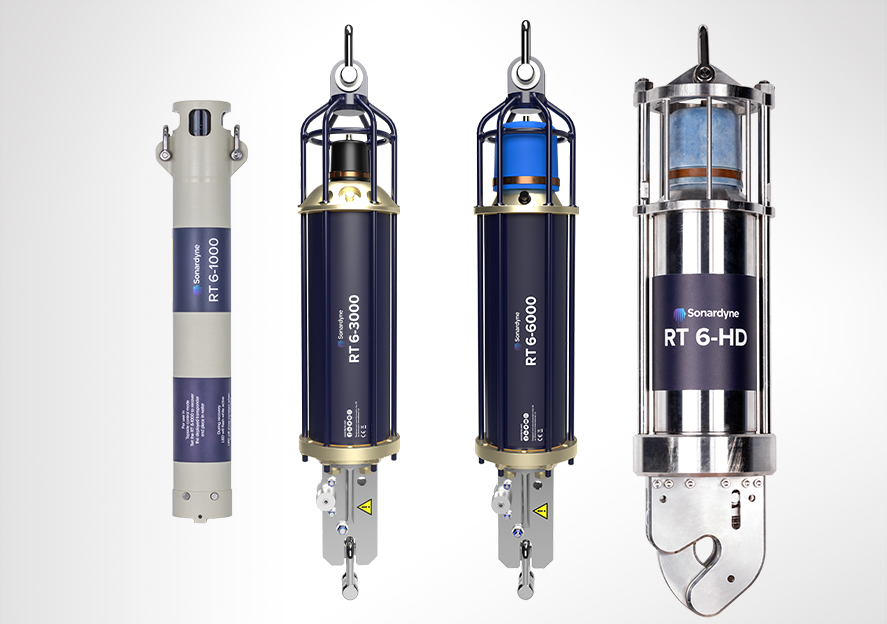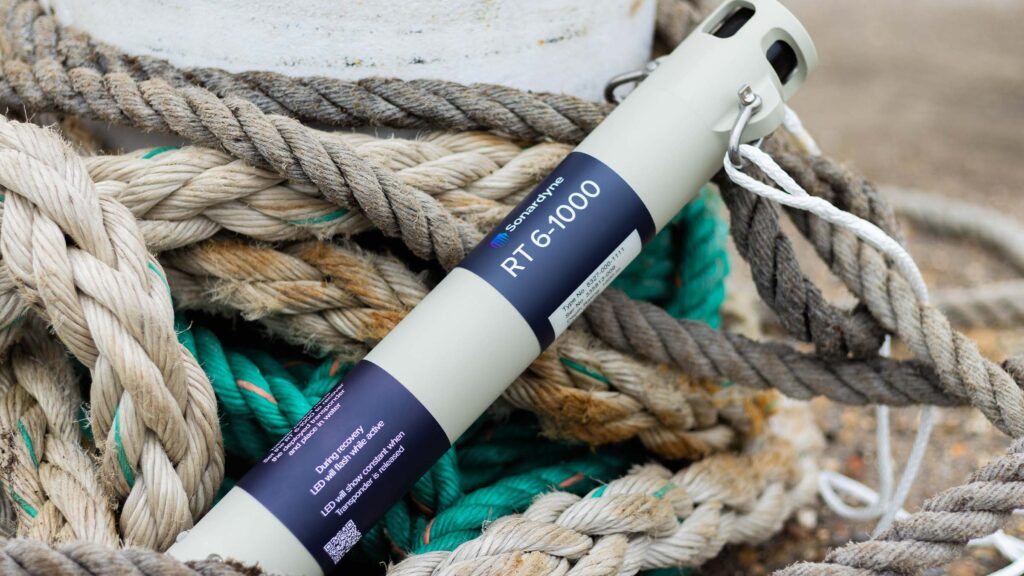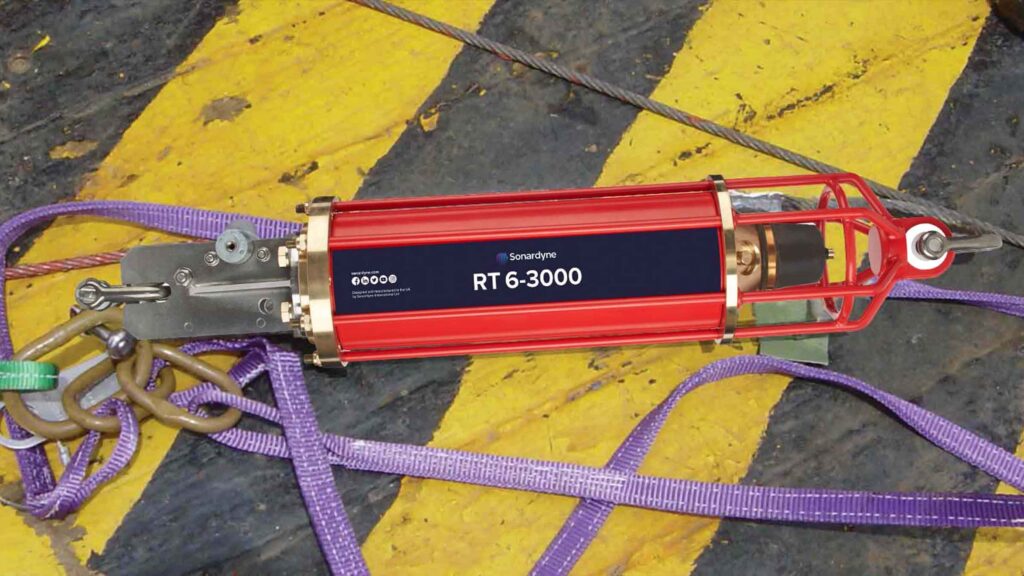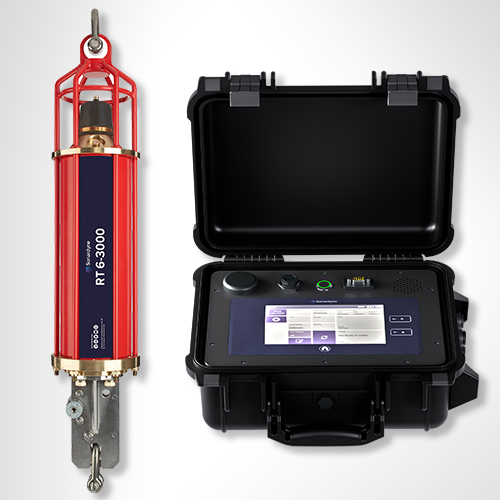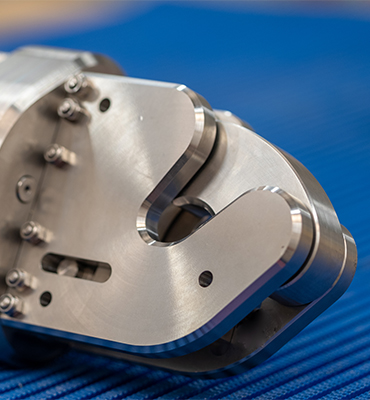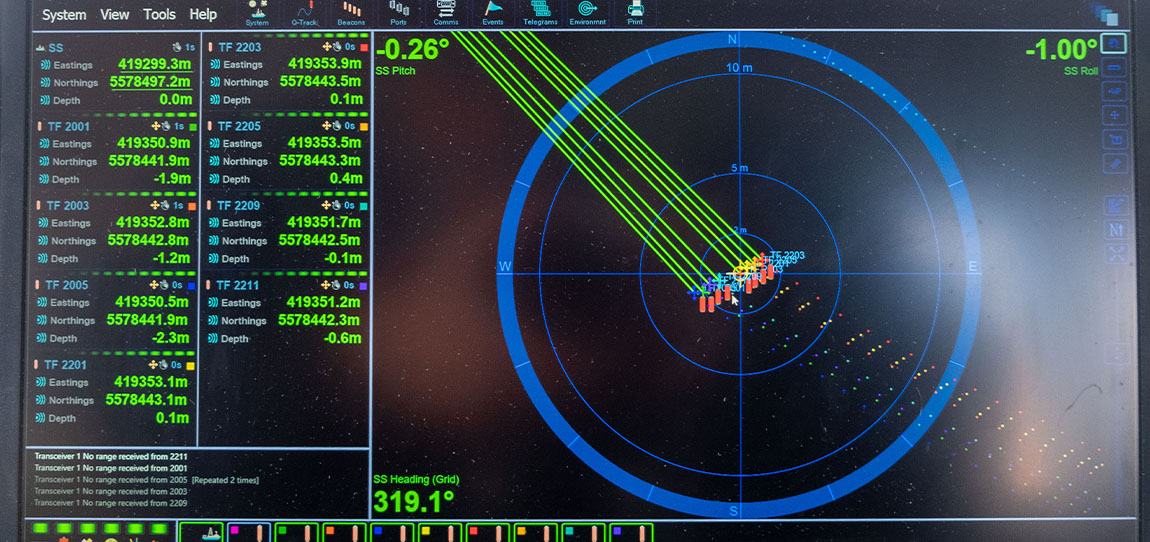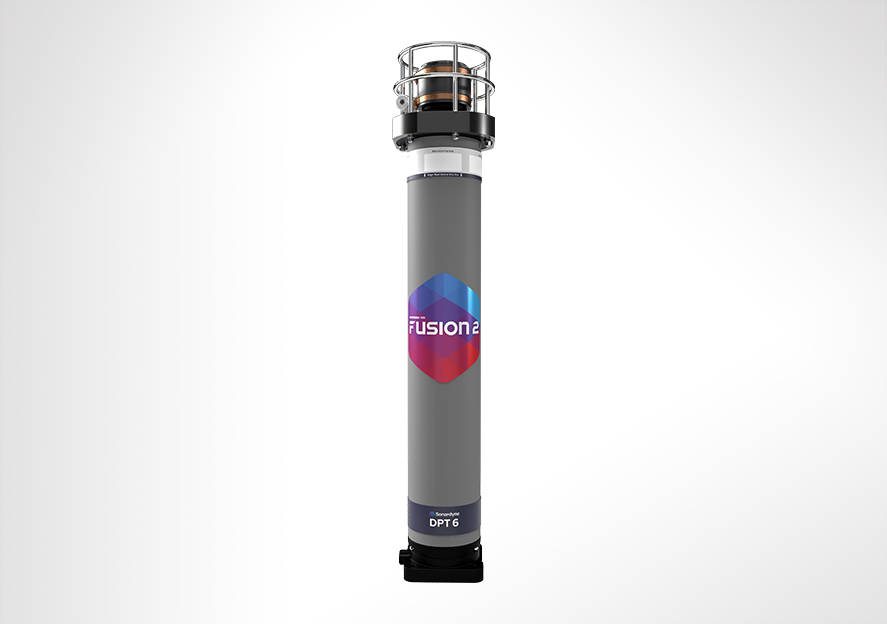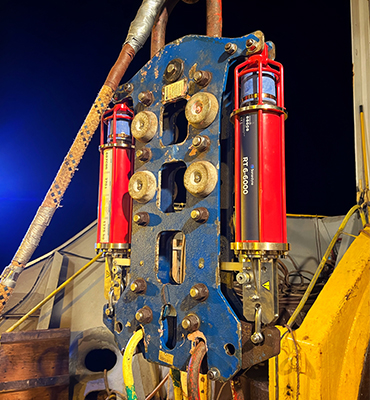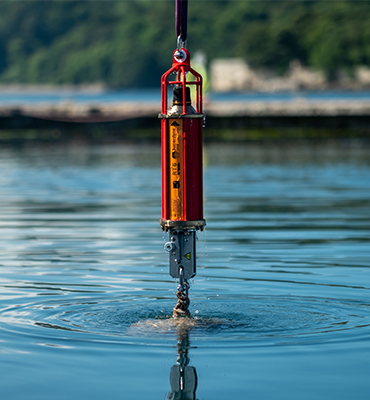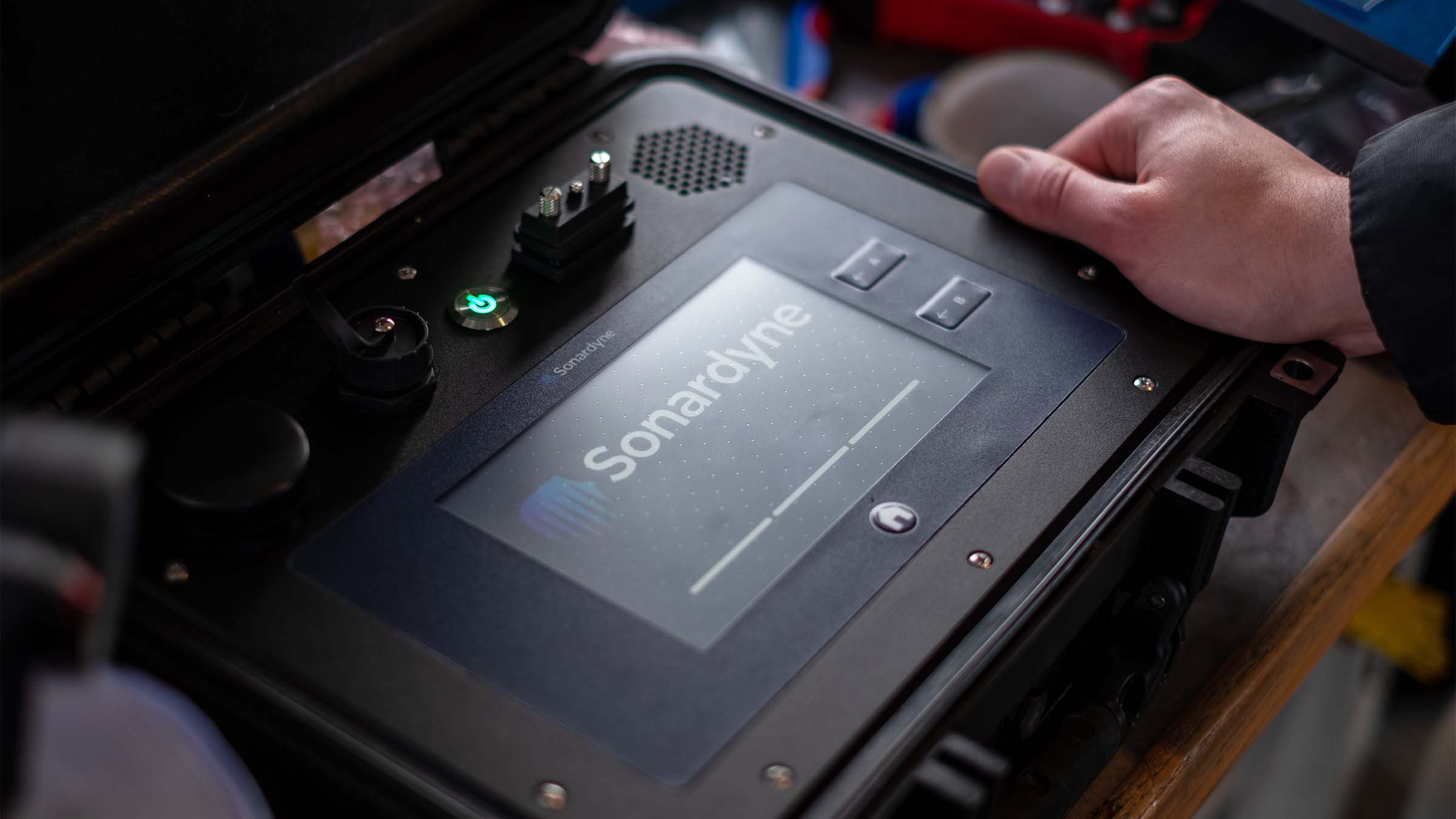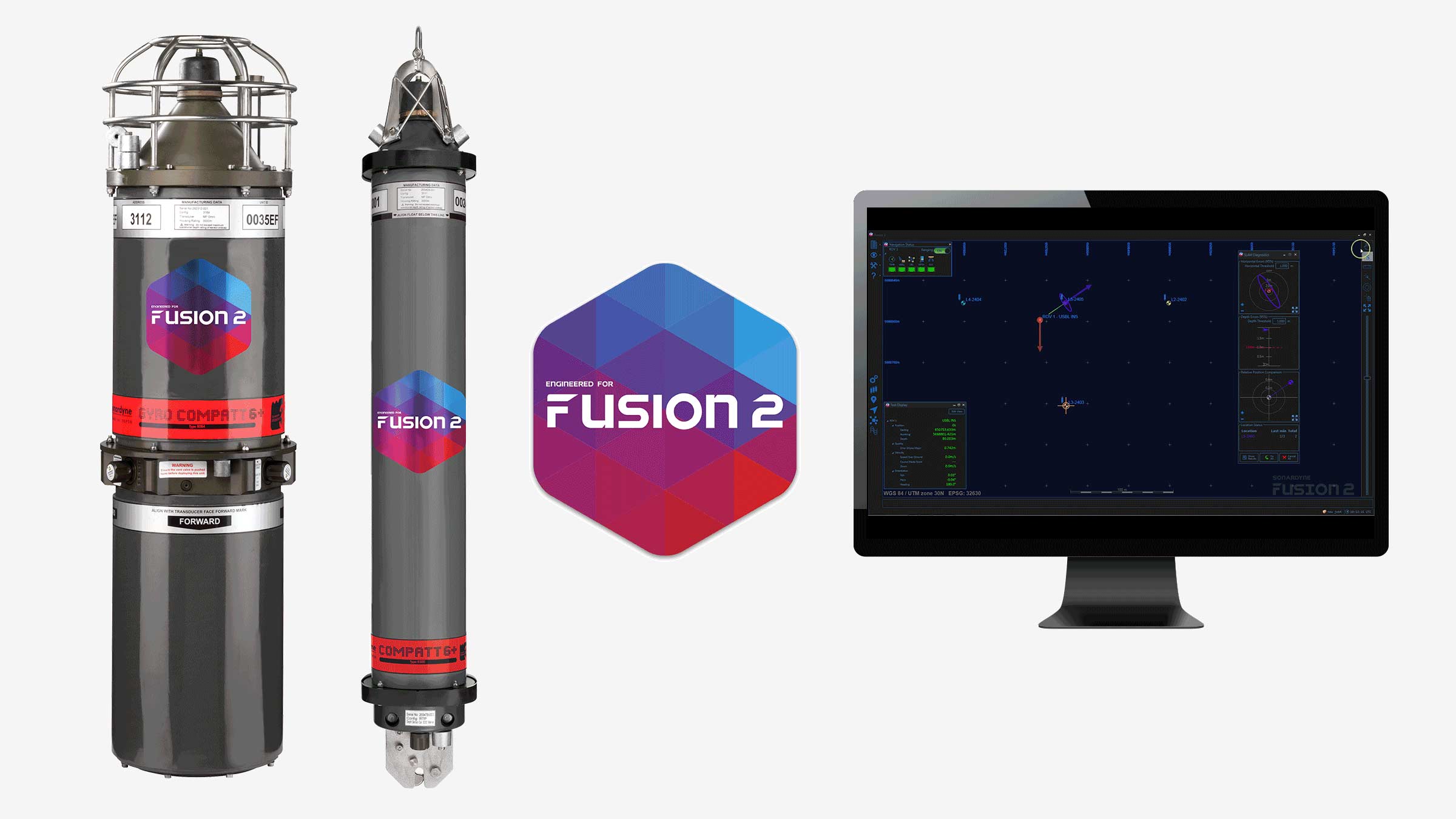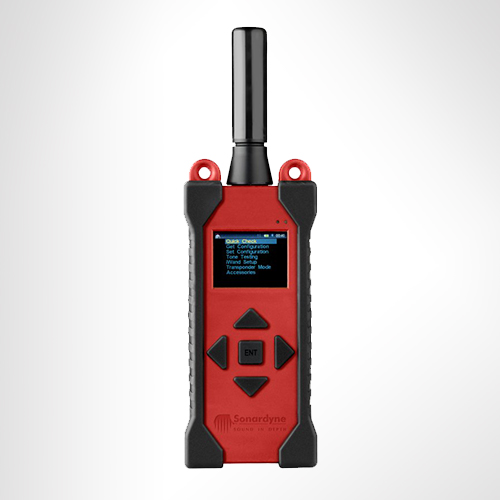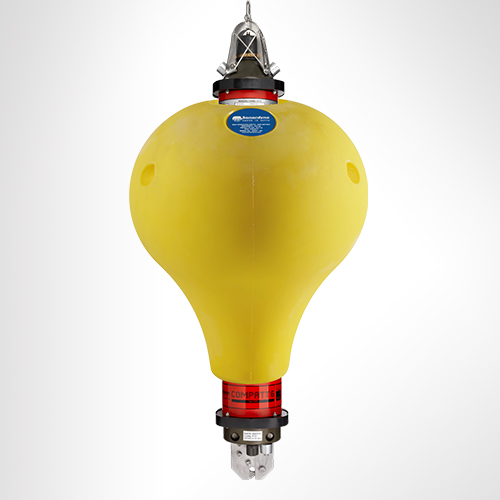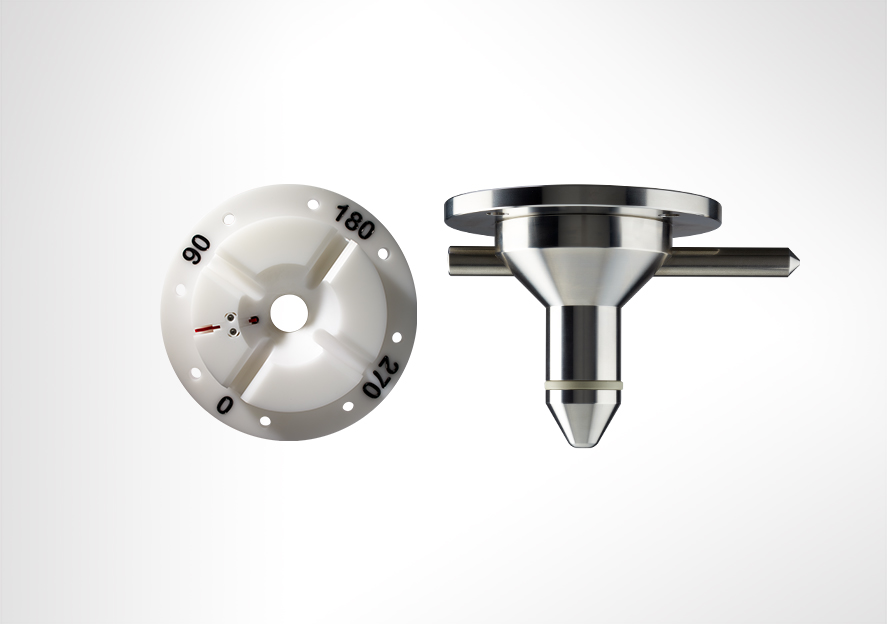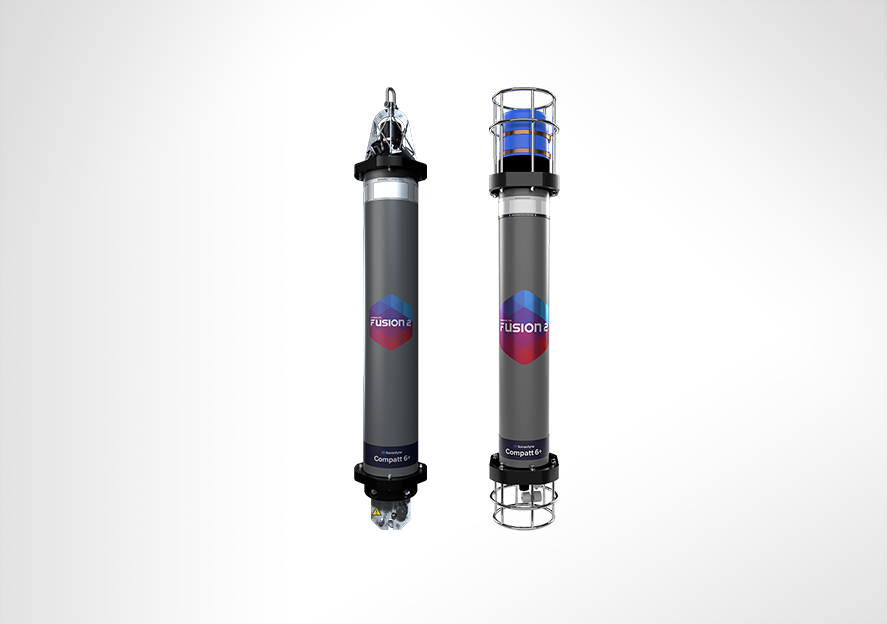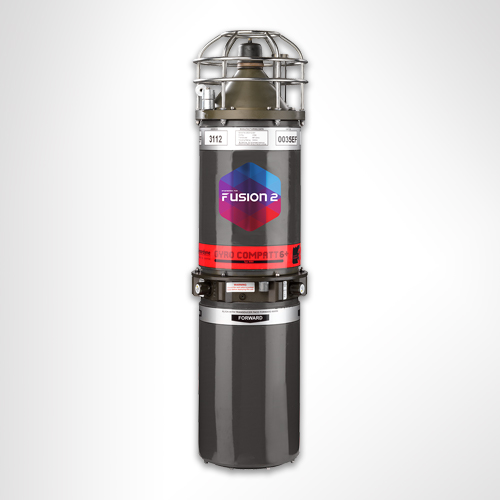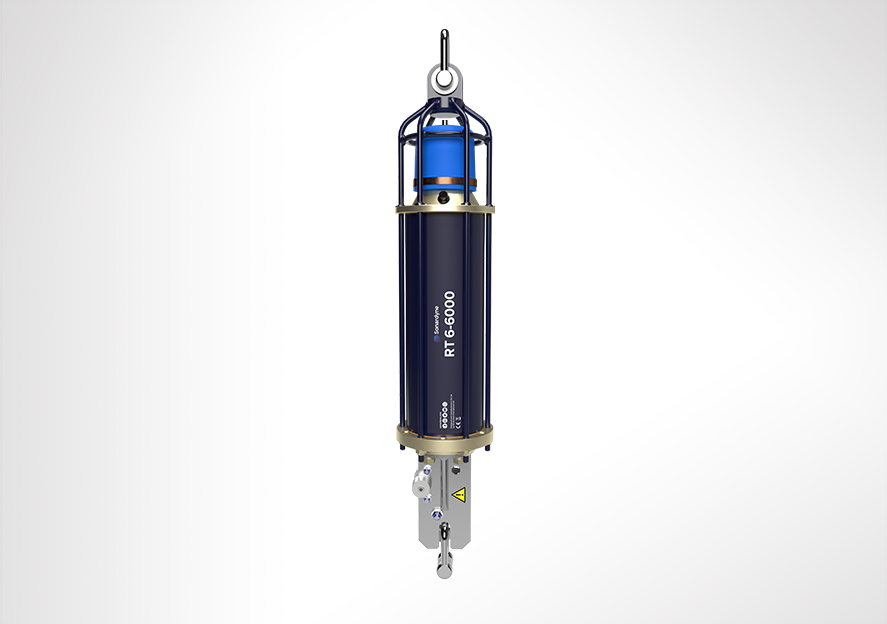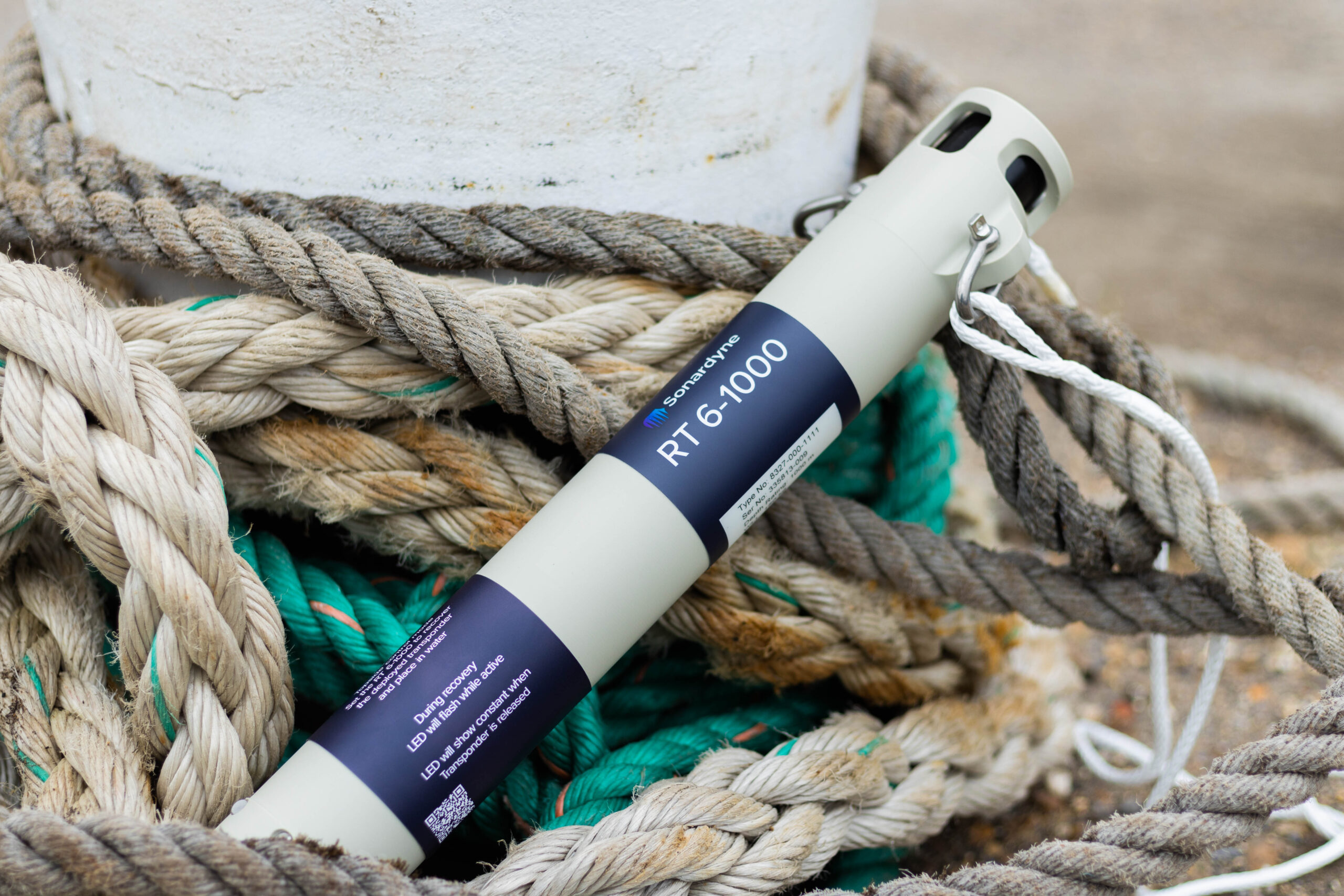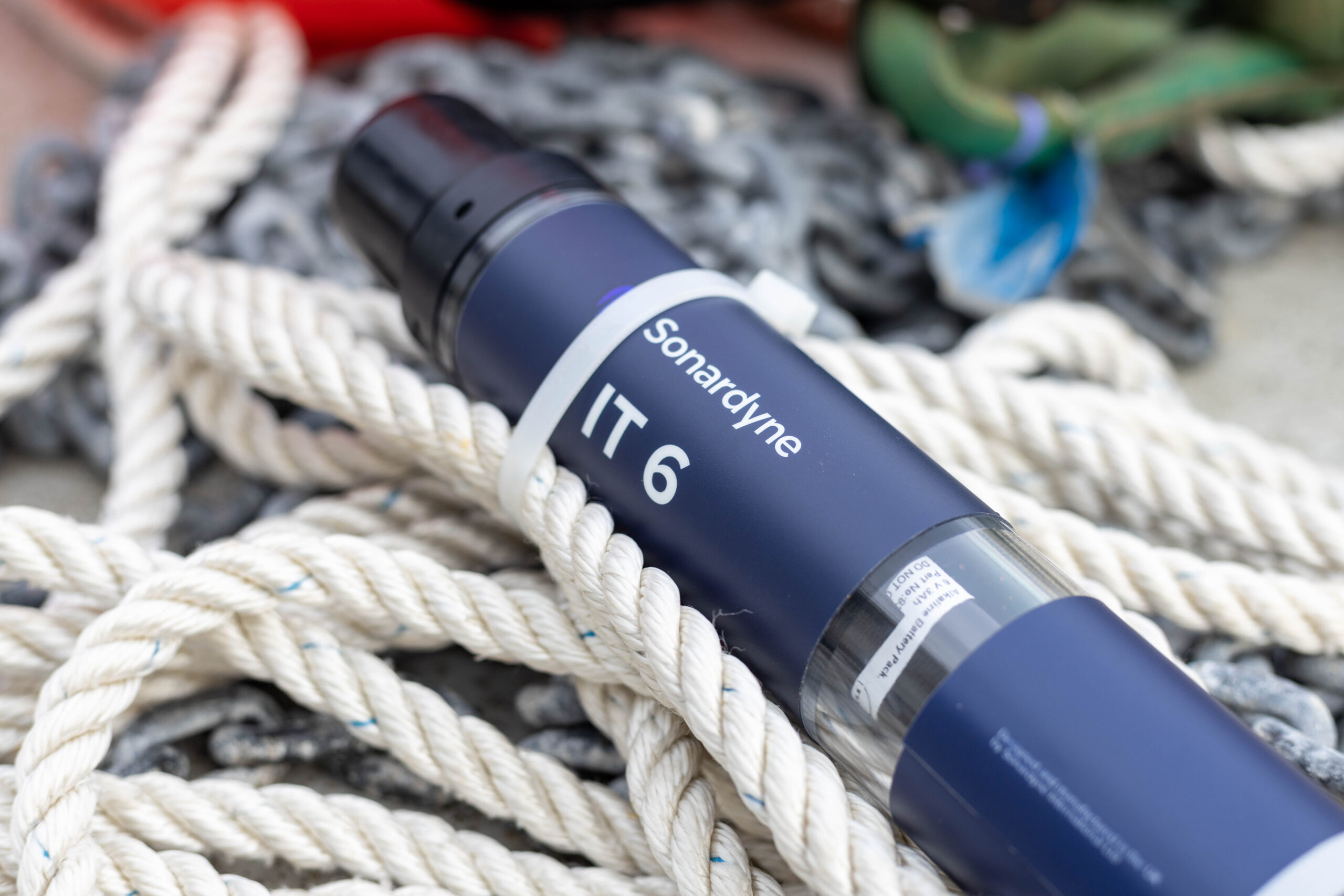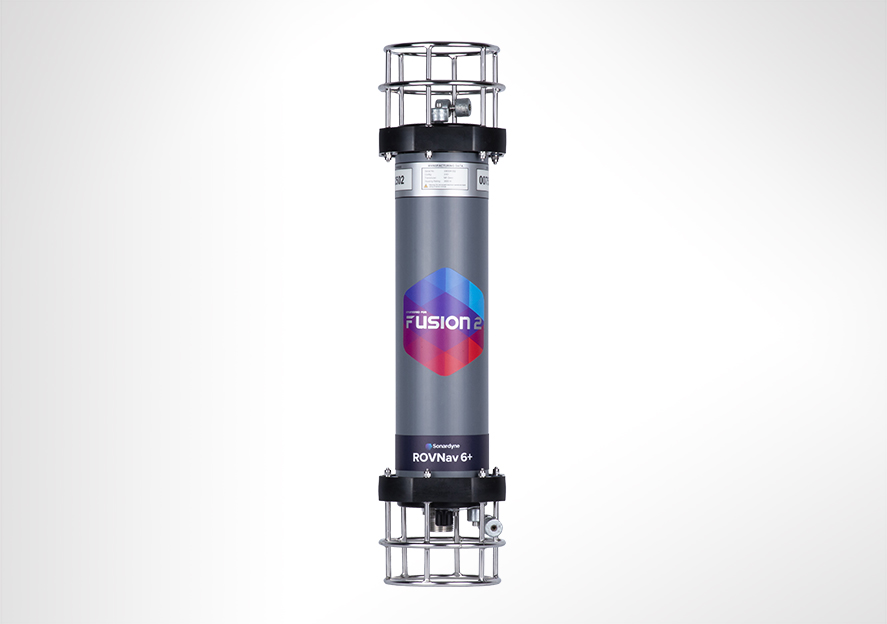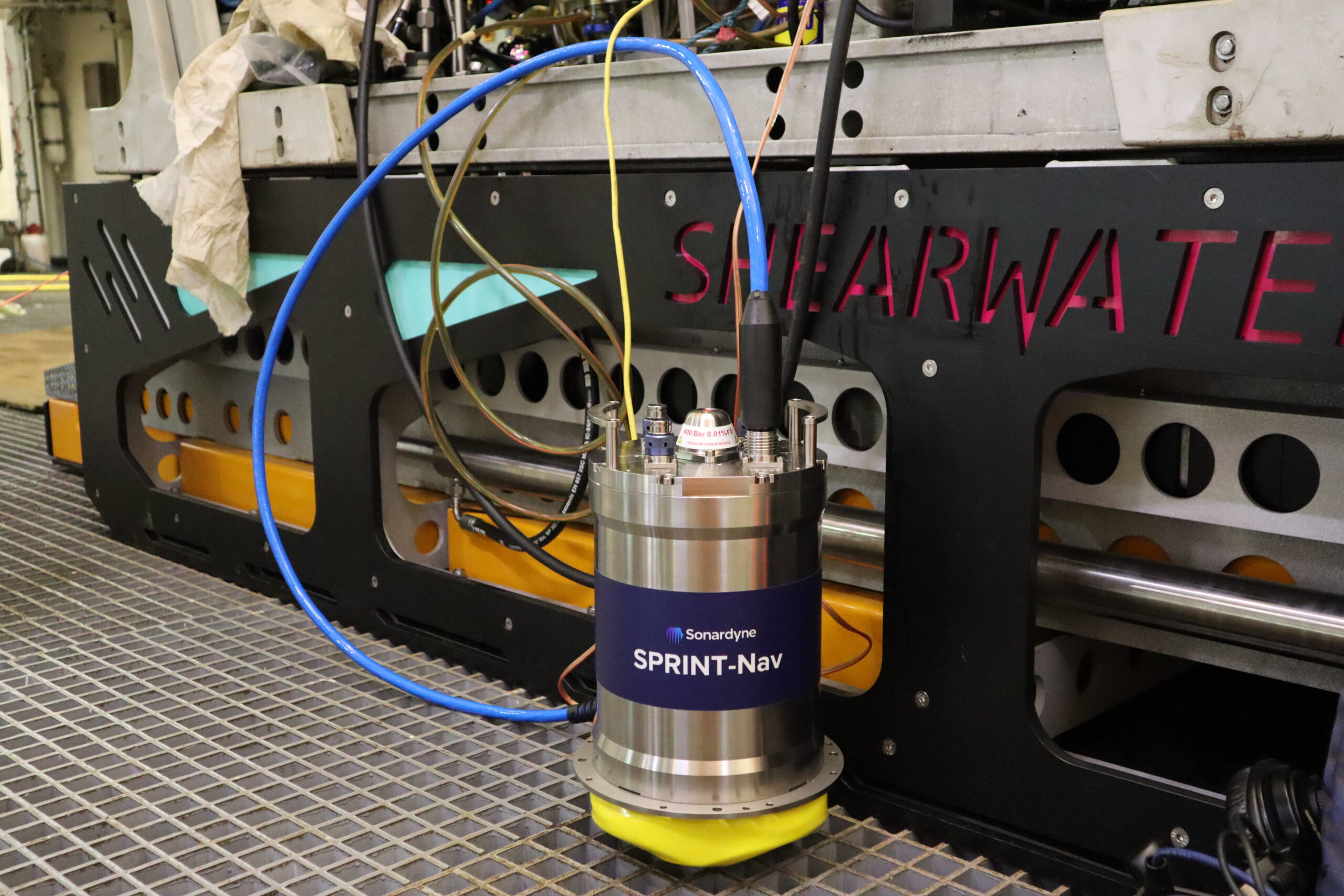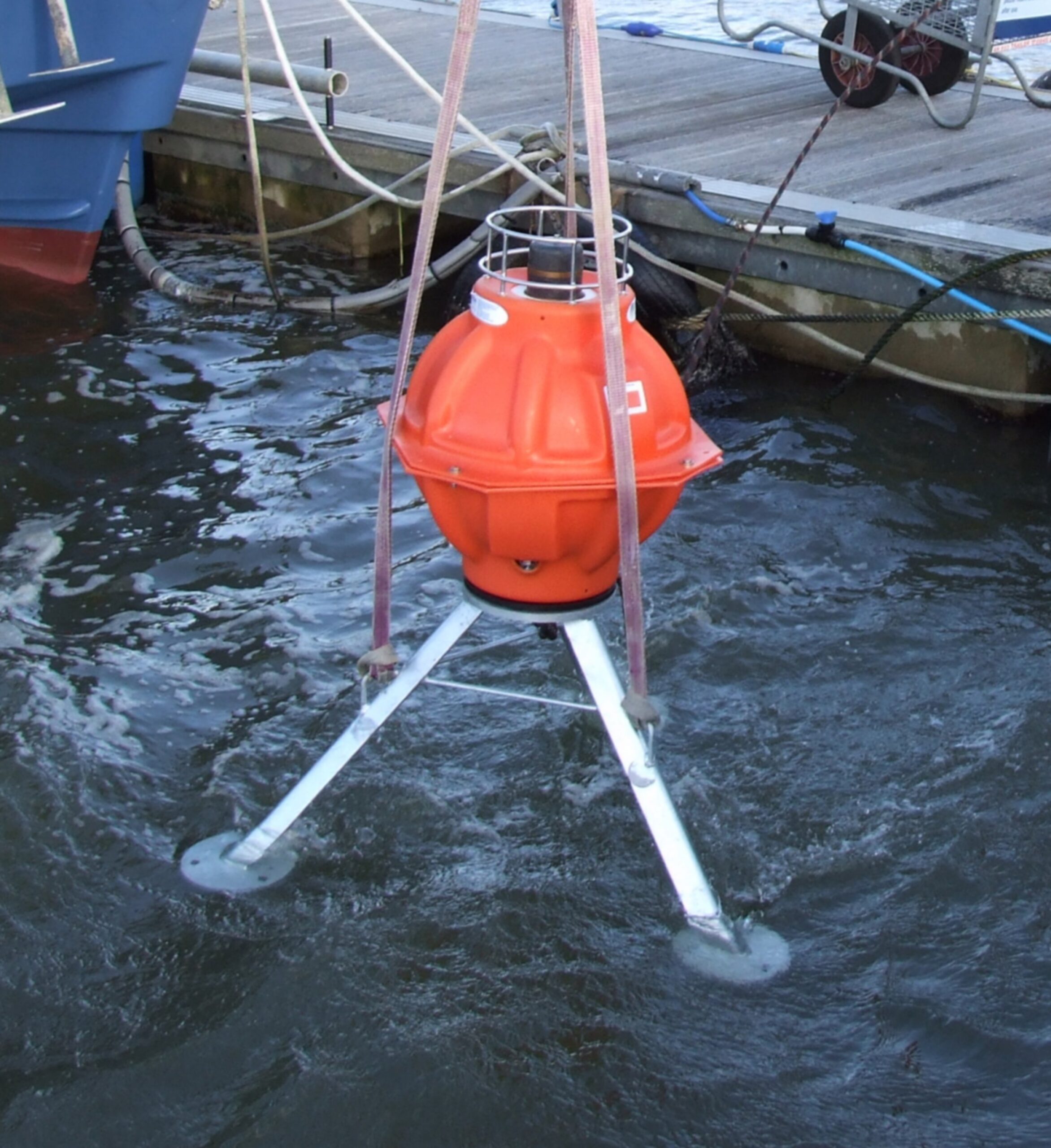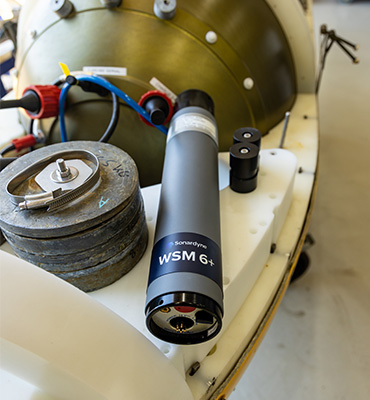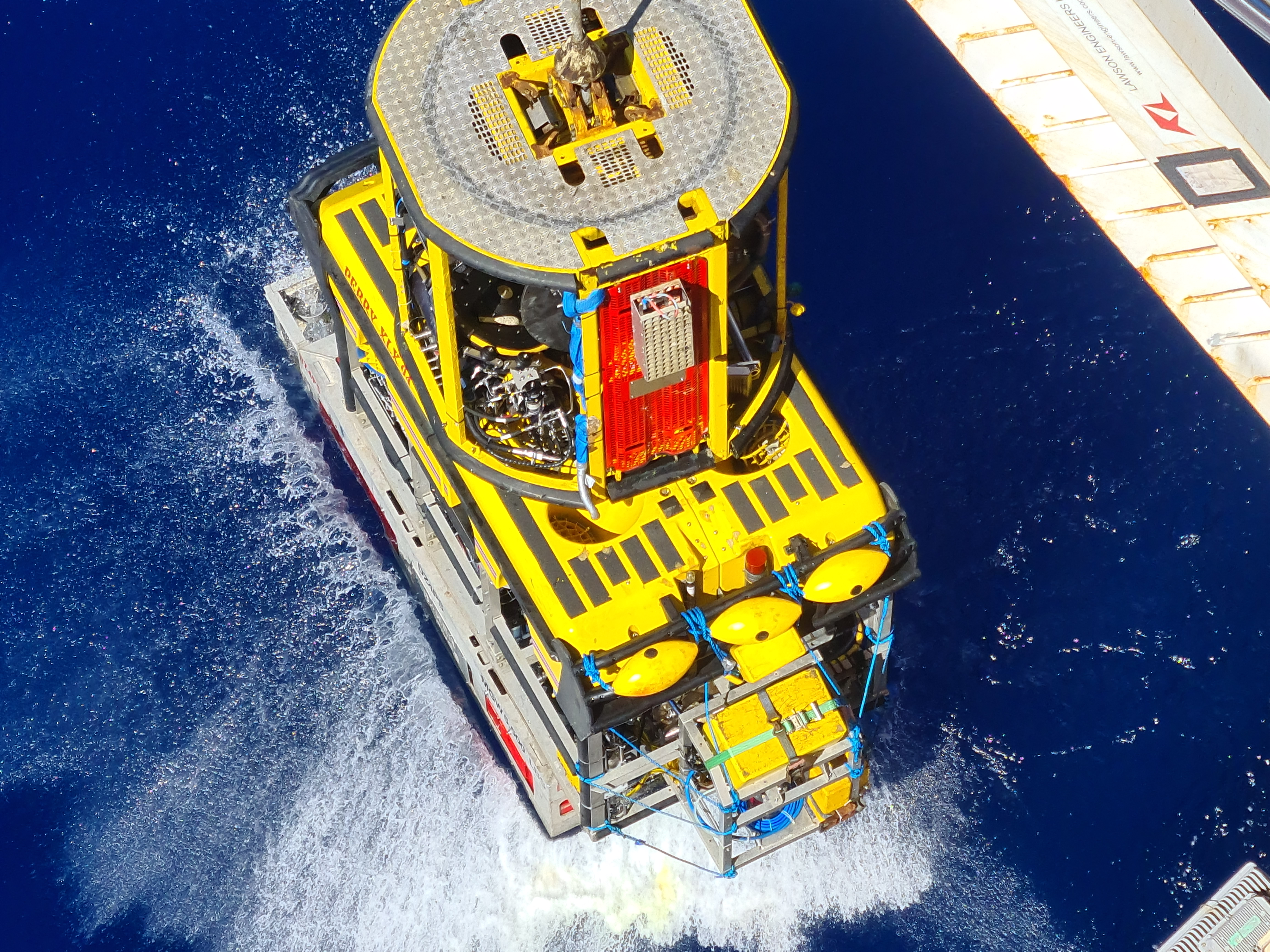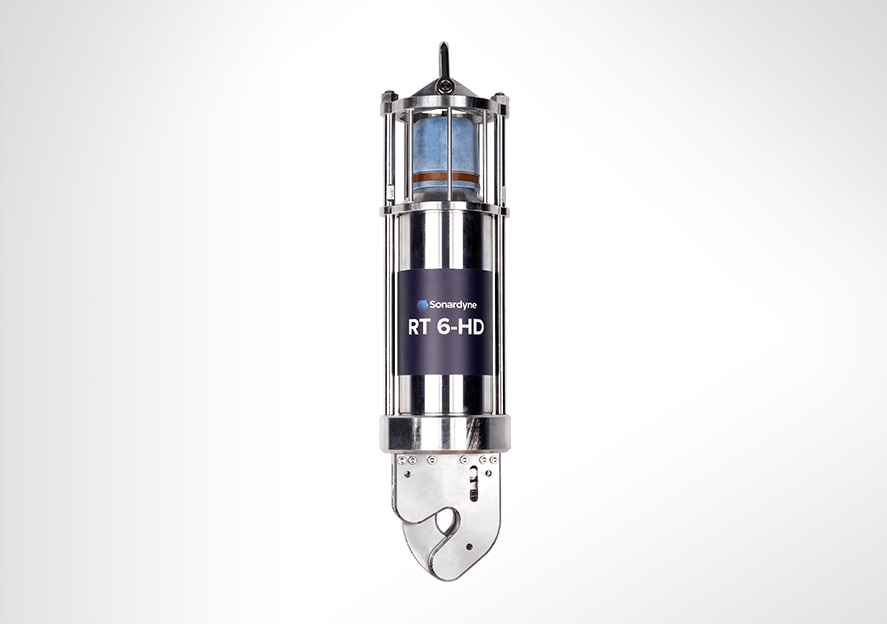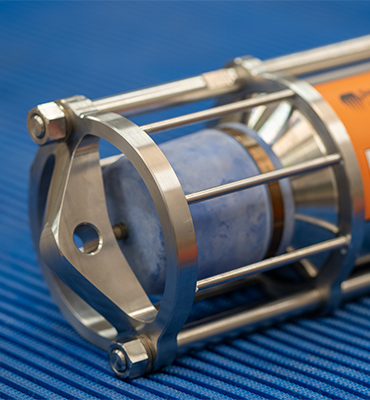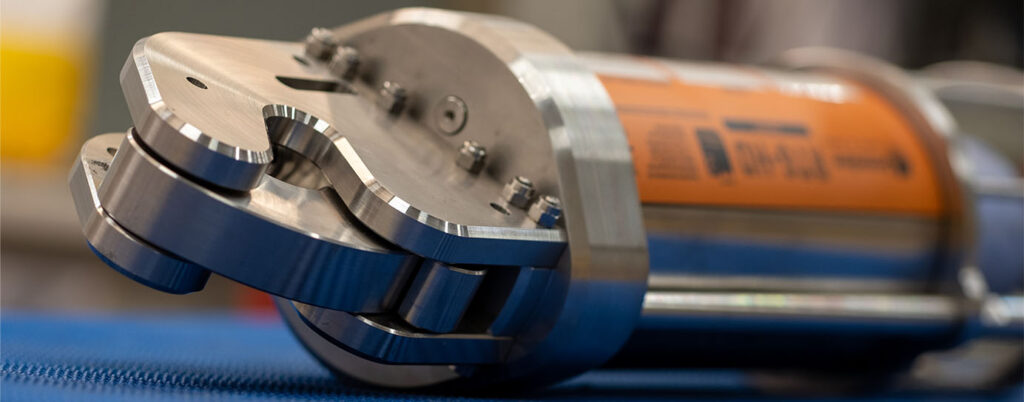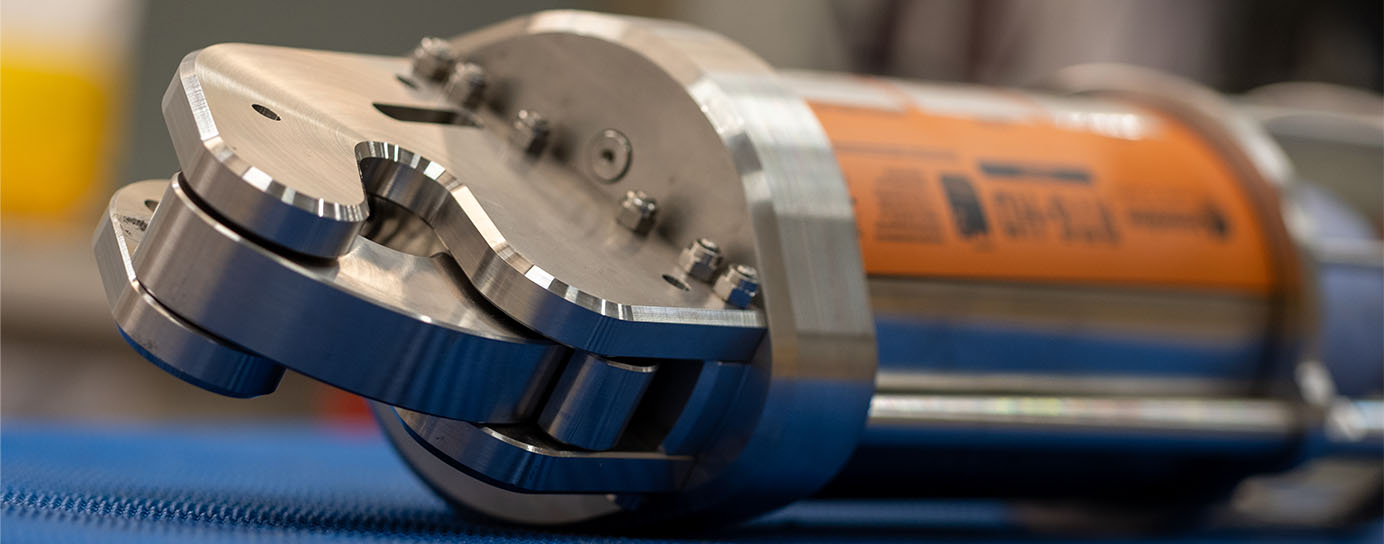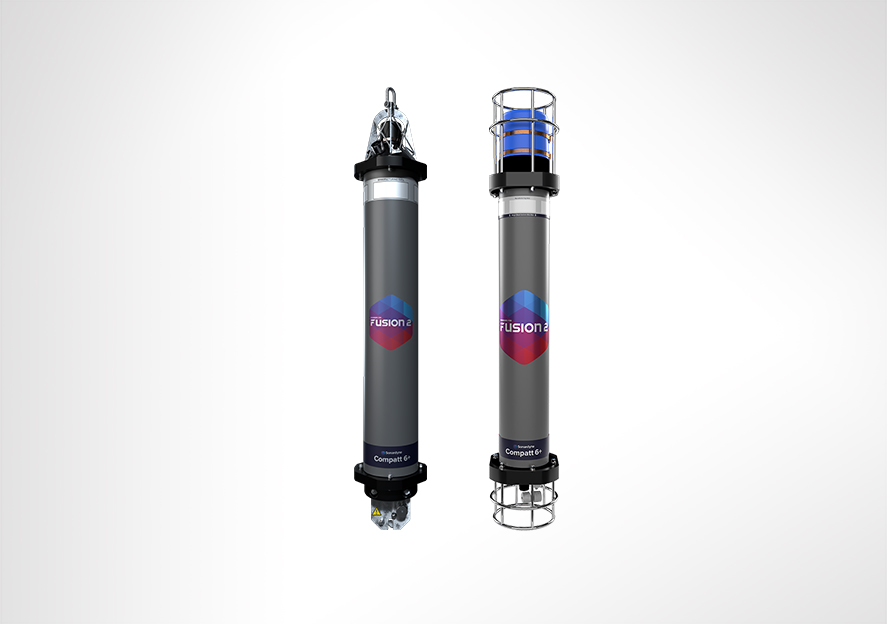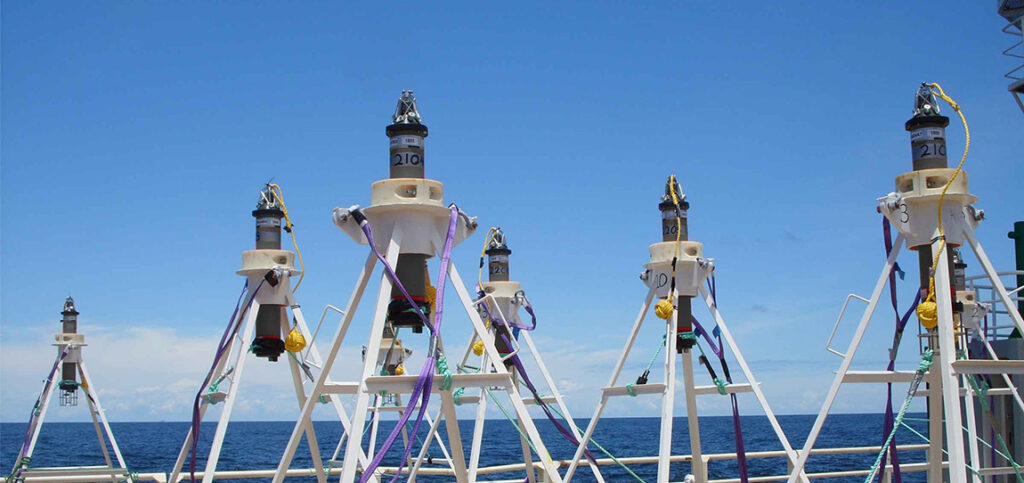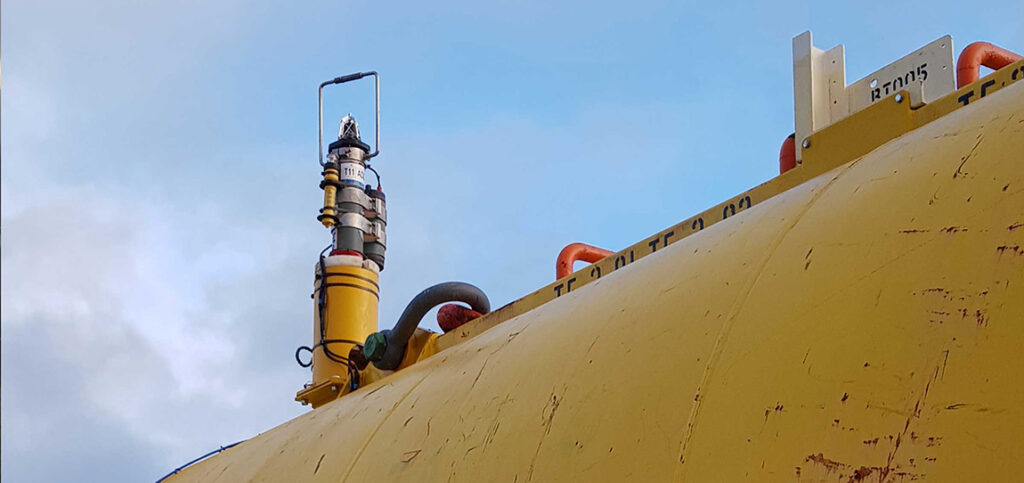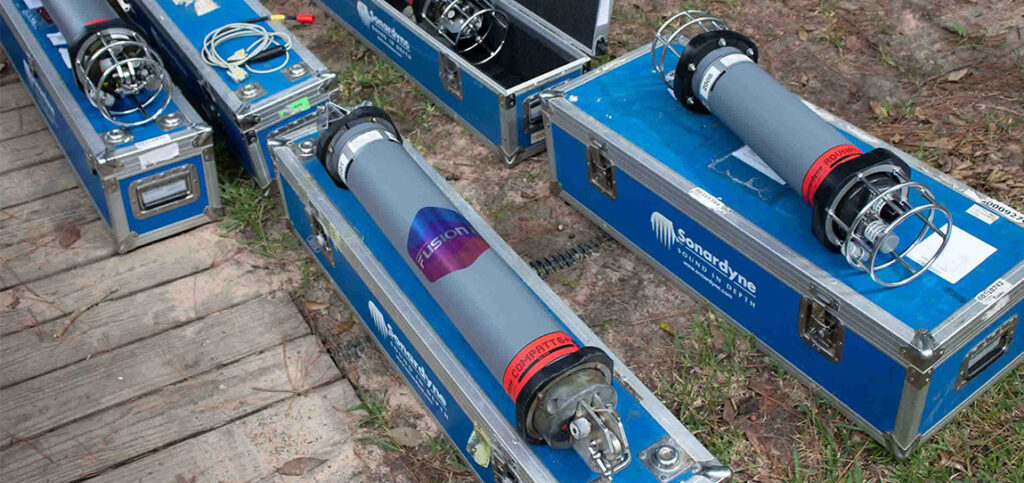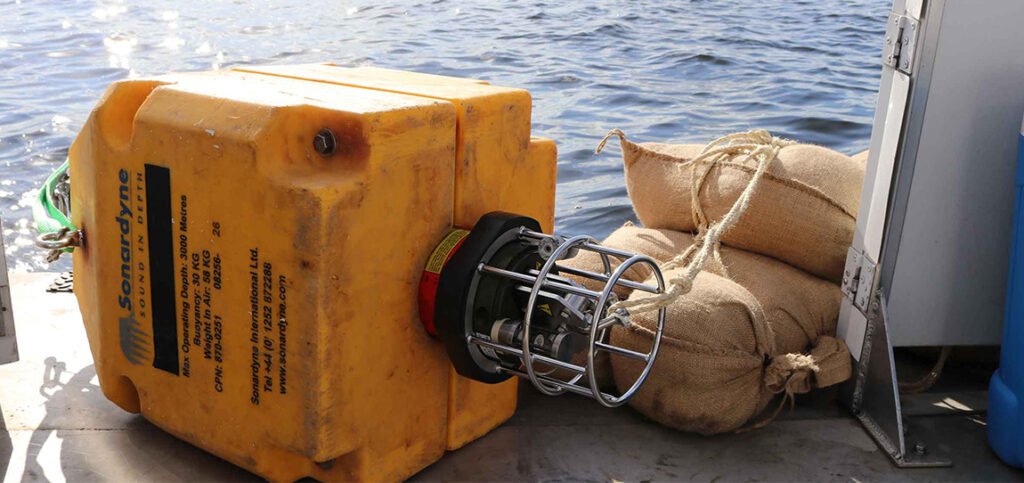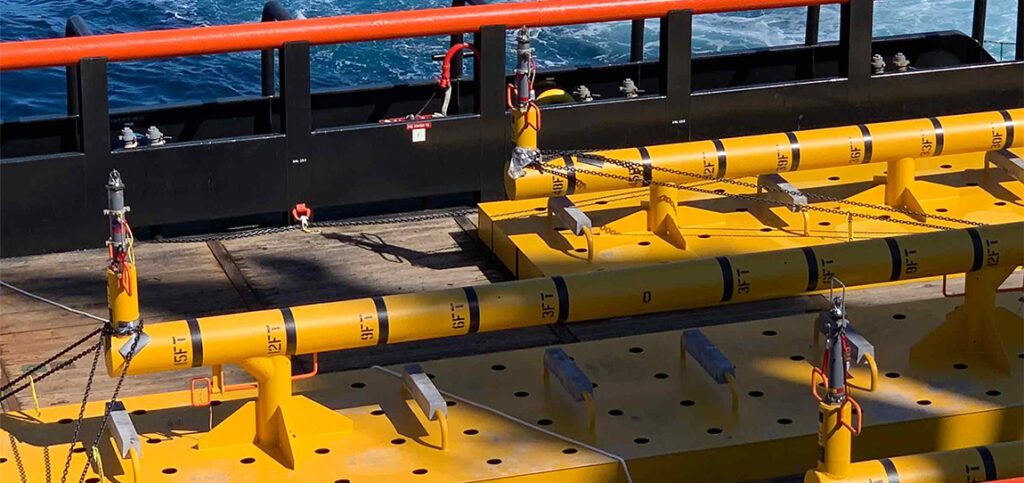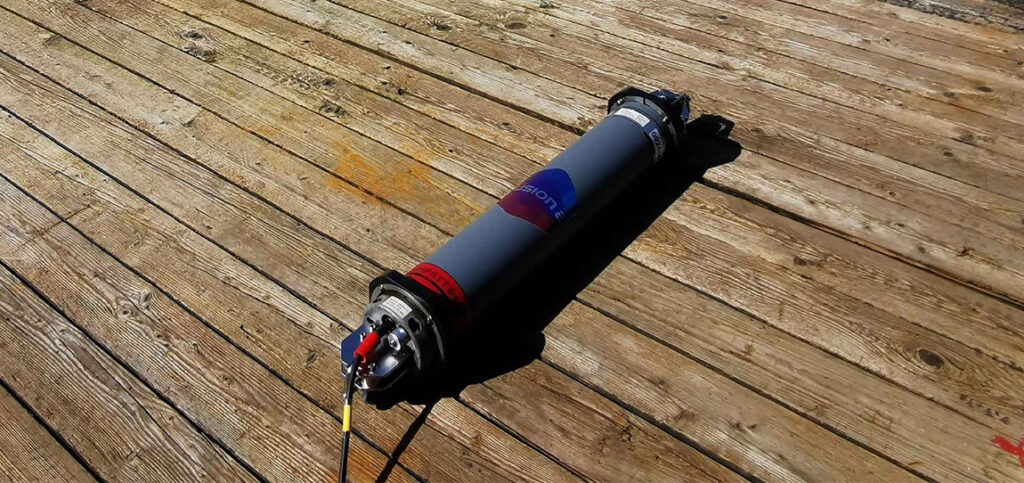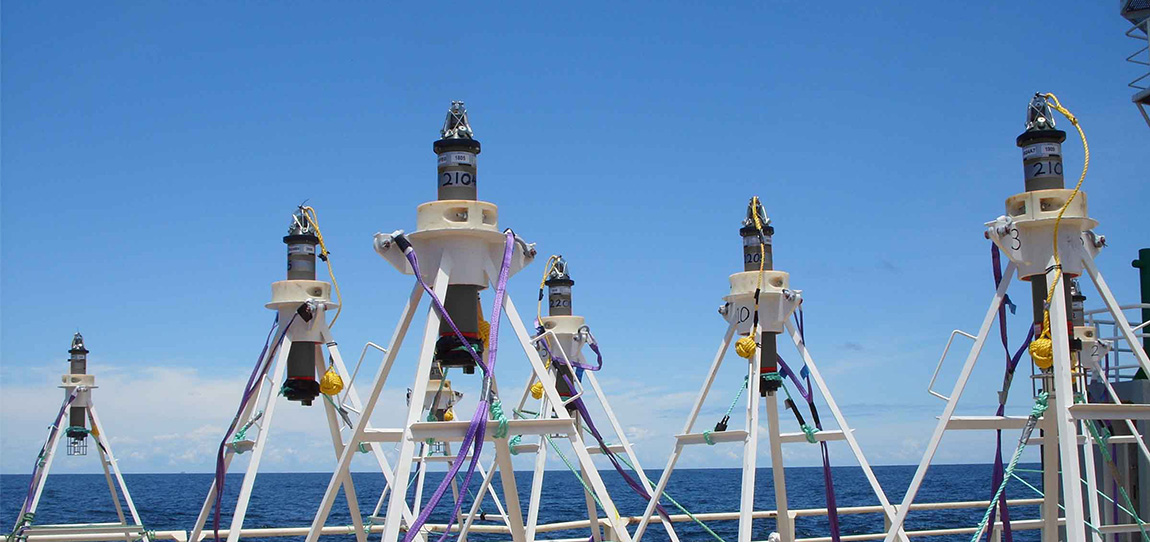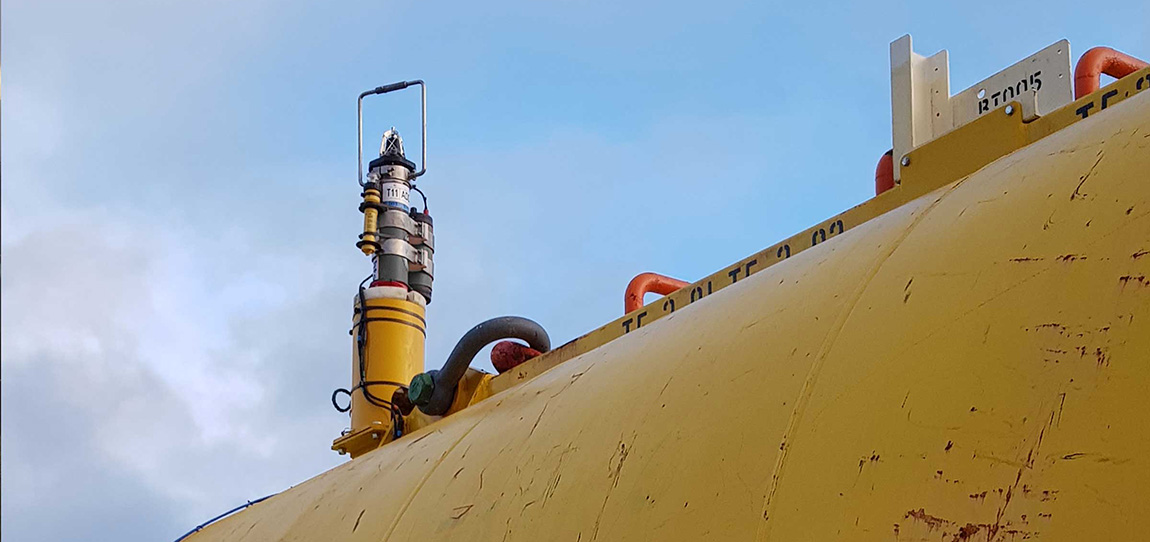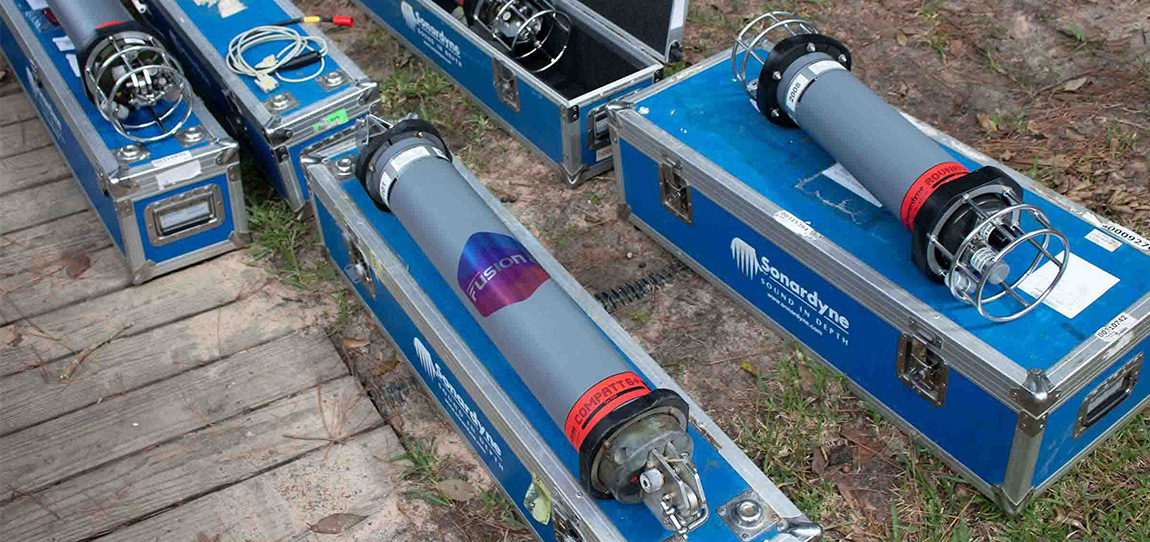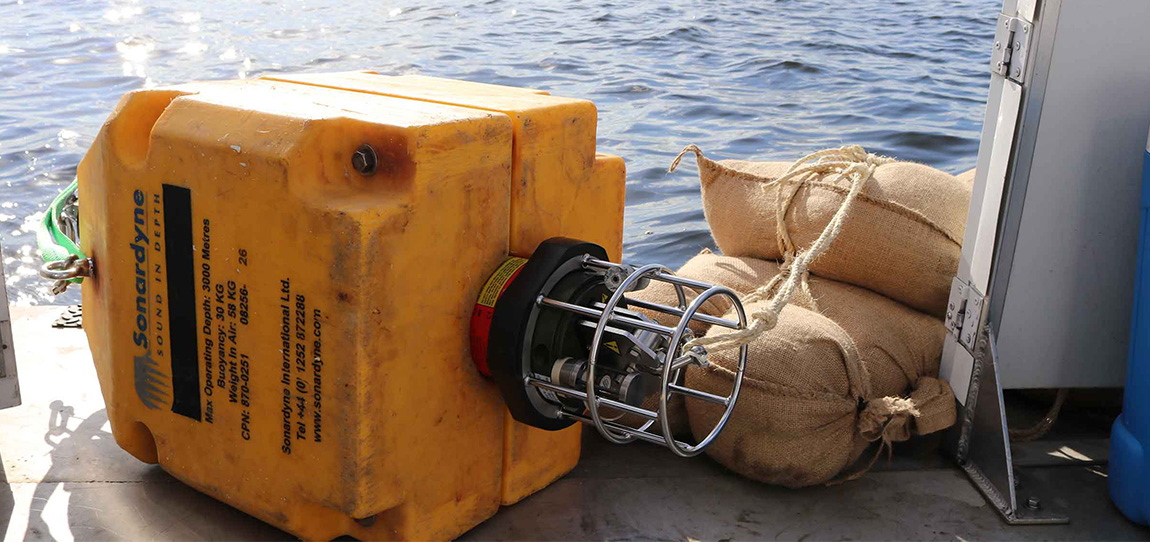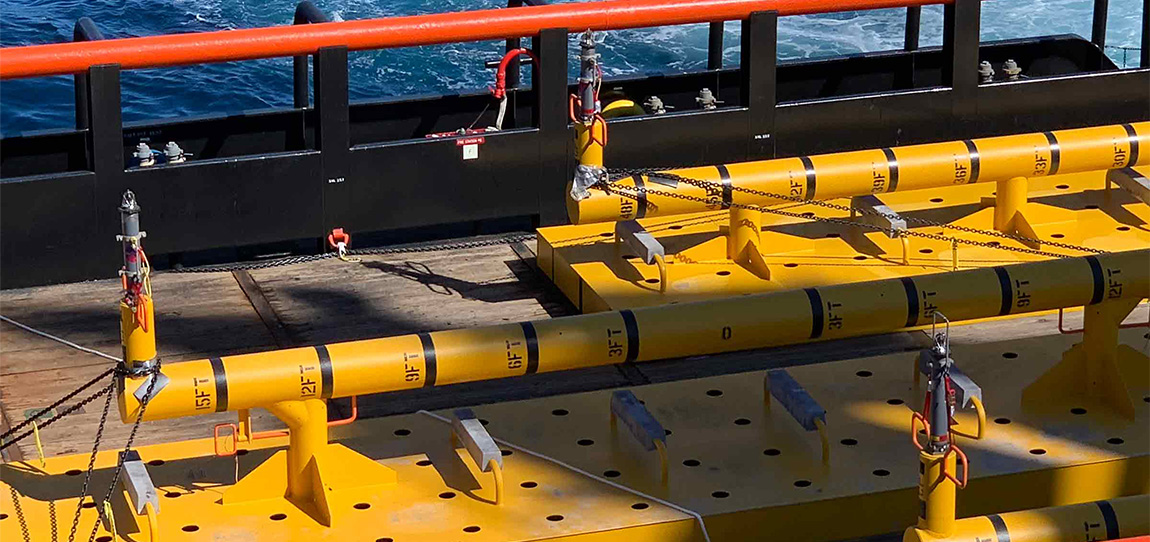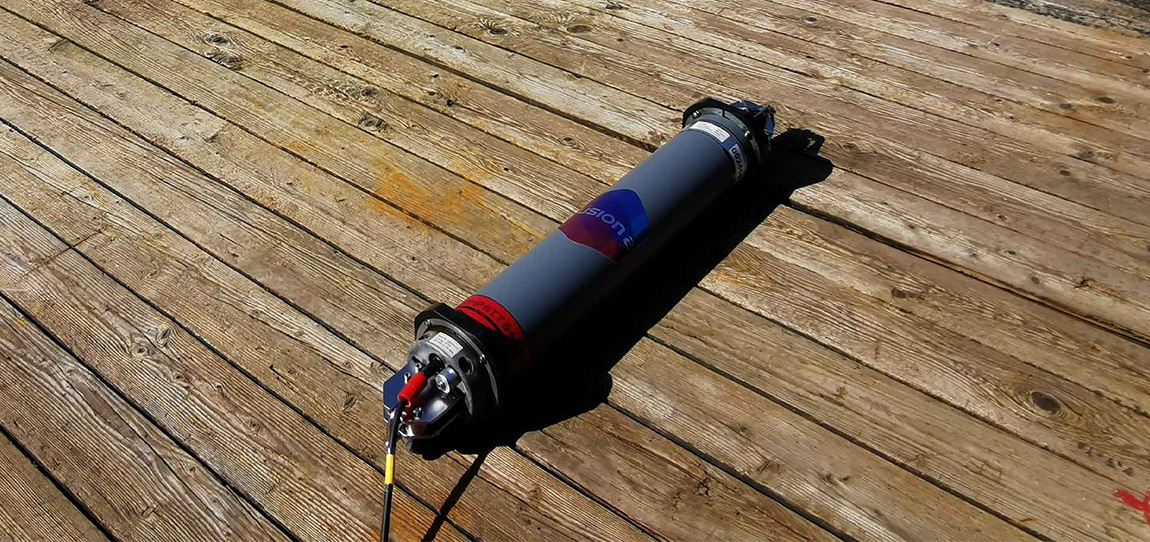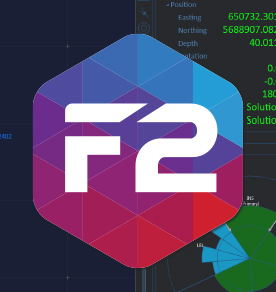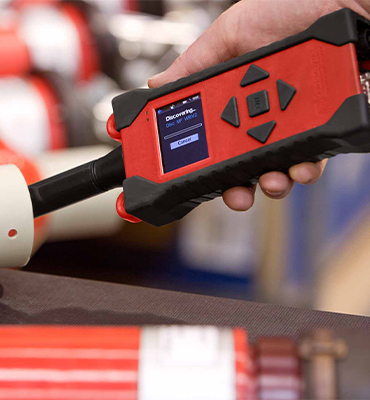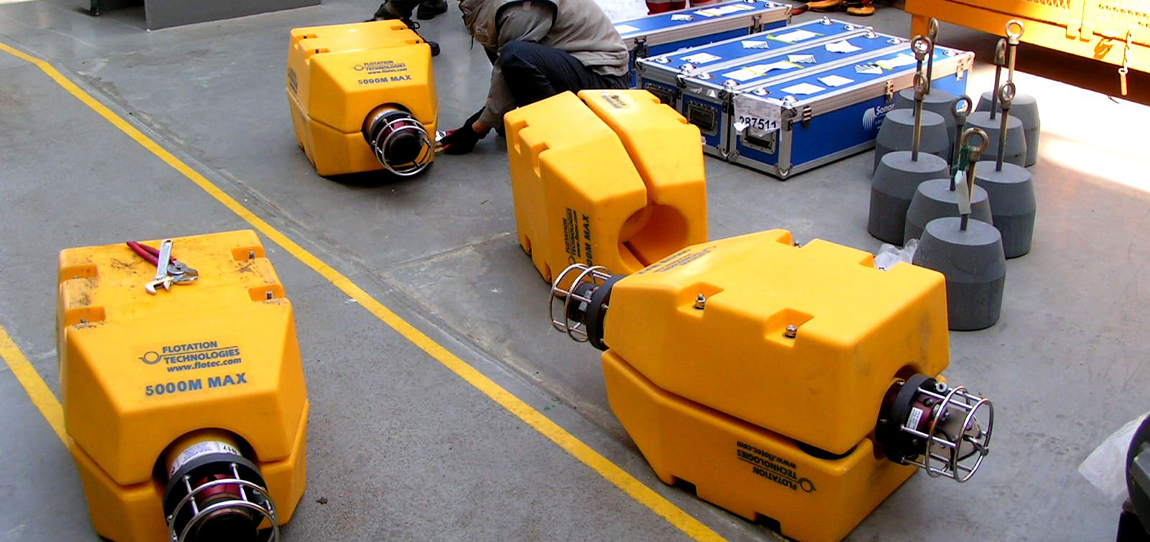Go deeper, last longer and lift more with our family of RT 6 acoustic releases
Our RT 6s come in three popular depth ratings, 1,000 m, 3,000 m and 6,000 m as well as an HD model capable of operating at up to 7,000 m with loads of up to 2500kg. There’s a model to suit any of your offshore operations.
All of our RT 6 models are compatible with our Ranger 2 USBL. You can locate, operate and recover the releases quickly and simply with this globally used system, saving you time and the complexity of operating several systems at once.
Spend less time recovering and more time collecting data with up to 2.5 years battery life. We understand that your time is precious, so our RT 6 releases feature a minimum of 13 months battery life, depending on the model, meaning you spend less time recovering equipment and your assets spend more time in operation.
RT 6. Supporting your science and equipment deployments – which one is right for you?
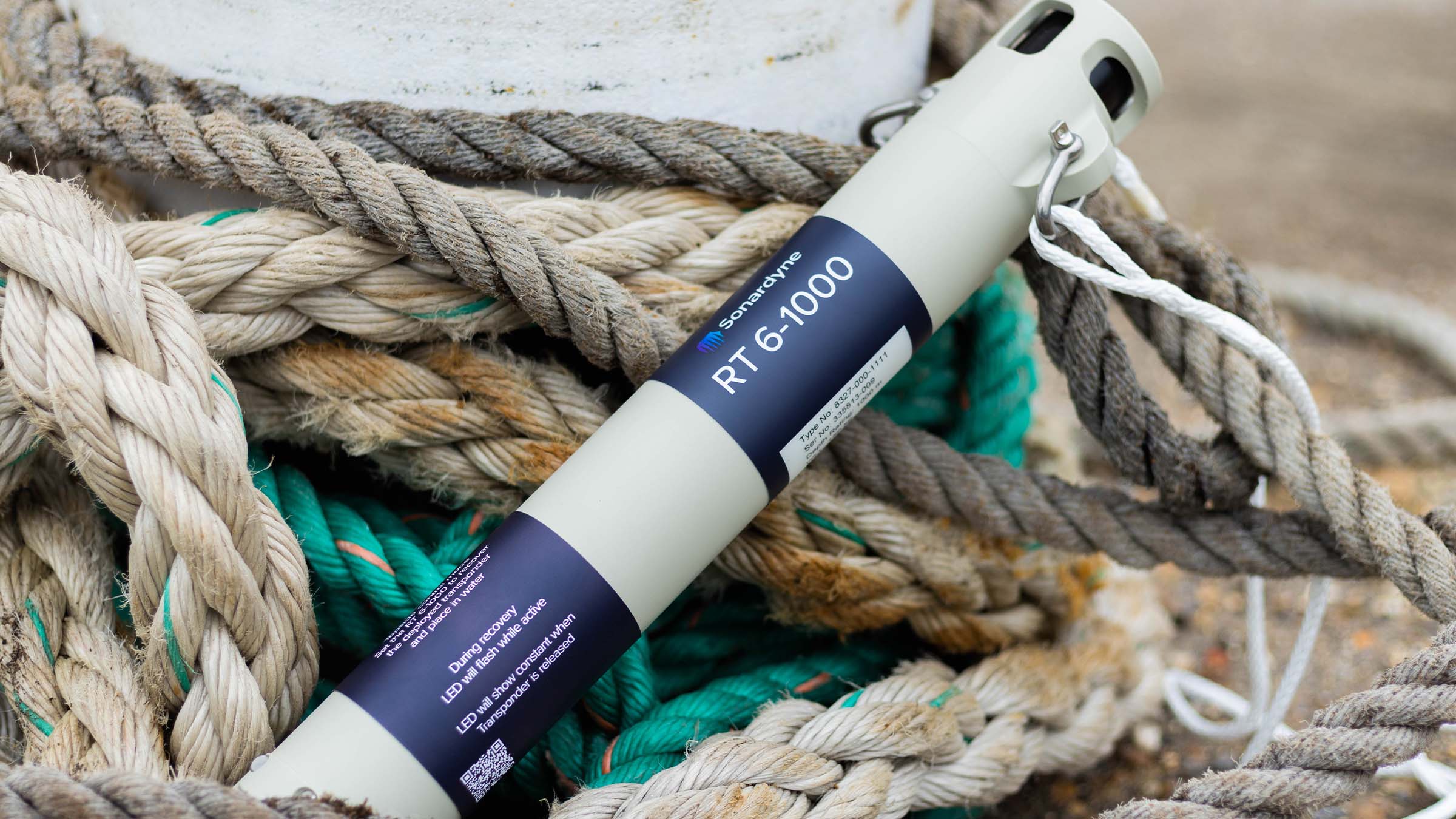
RT 6-1000
Deploy it. Track it. Locate it. Recover it. RT 6-1000 does it all. Our new entry-level acoustic release transponder has features that are far from entry-level. Such as 1,000 metre depth rating, battery life of over a year and release mechanism that won’t let you down. The perfect low-cost acoustic release for mooring environmental sensors. 1,000 metre depth rating, 18 months battery life, 125 kg WLL. Ranger 2 and Android app compatible.
Depth rating 1,000 m
Frequency MF
Working Load Limit 150 kg
Battery life >13 months
Topside Android App/Ranger 2/Dunker 6 Kit
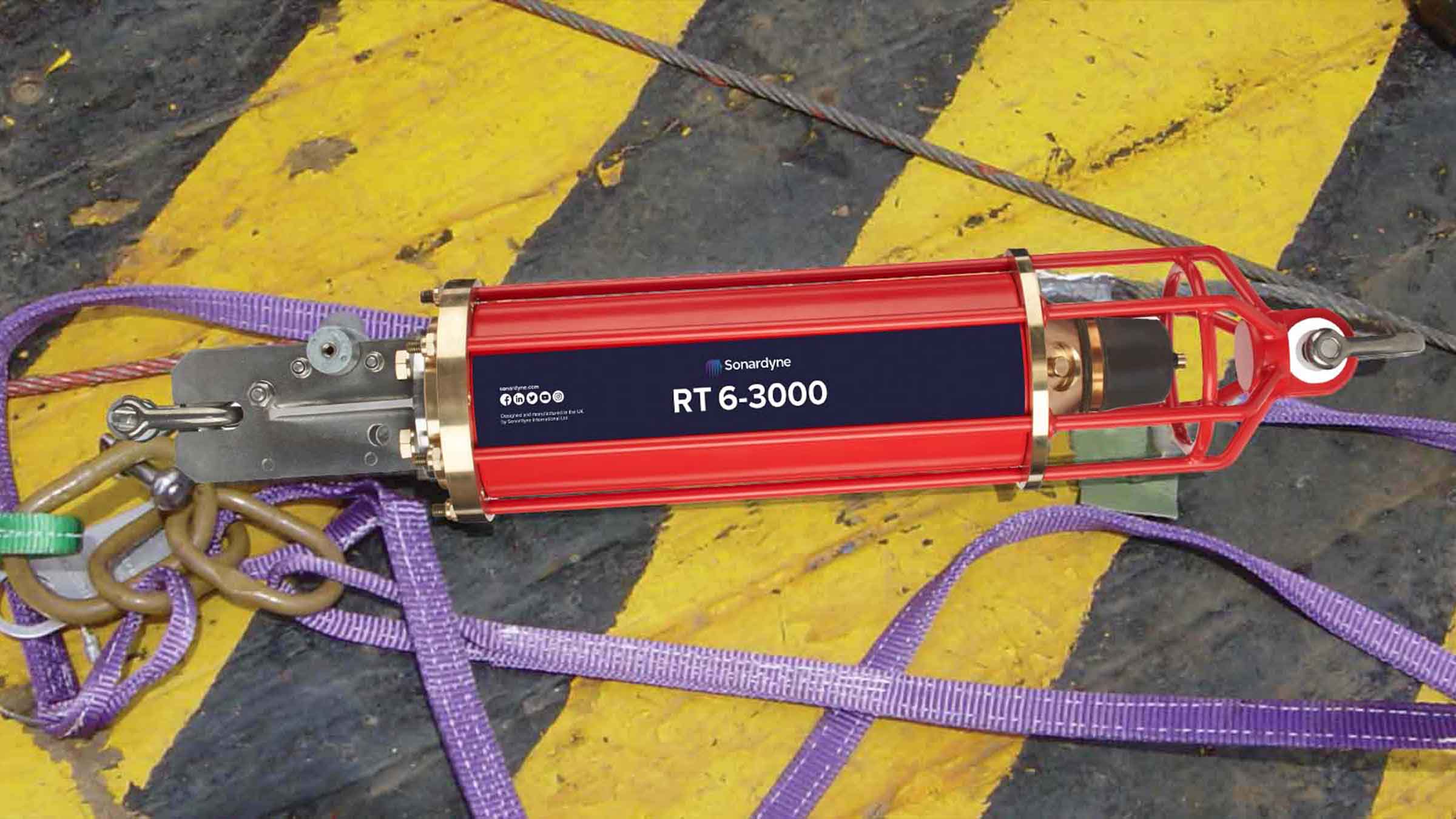
RT 6-3000
Deep water instrument mooring or structure installation; RT 6-3000 takes the hard work out of your deploying ocean sensors and heavy lifting. It features an impressive battery life of over 32 months and a depth rating of 3,000 m. Suitable for a wide range of sustained observation tasks spanning years of in-situ measurements. Depth rating to 6,000 metres and 1,275 kg WLL. Release with Ranger 2.
Depth rating 3,000/6,000 m
Frequency MF/LMF
Working load limit 1,275 kg
Battery life >32 months
Topside Deck Topside /Ranger 2 USBL
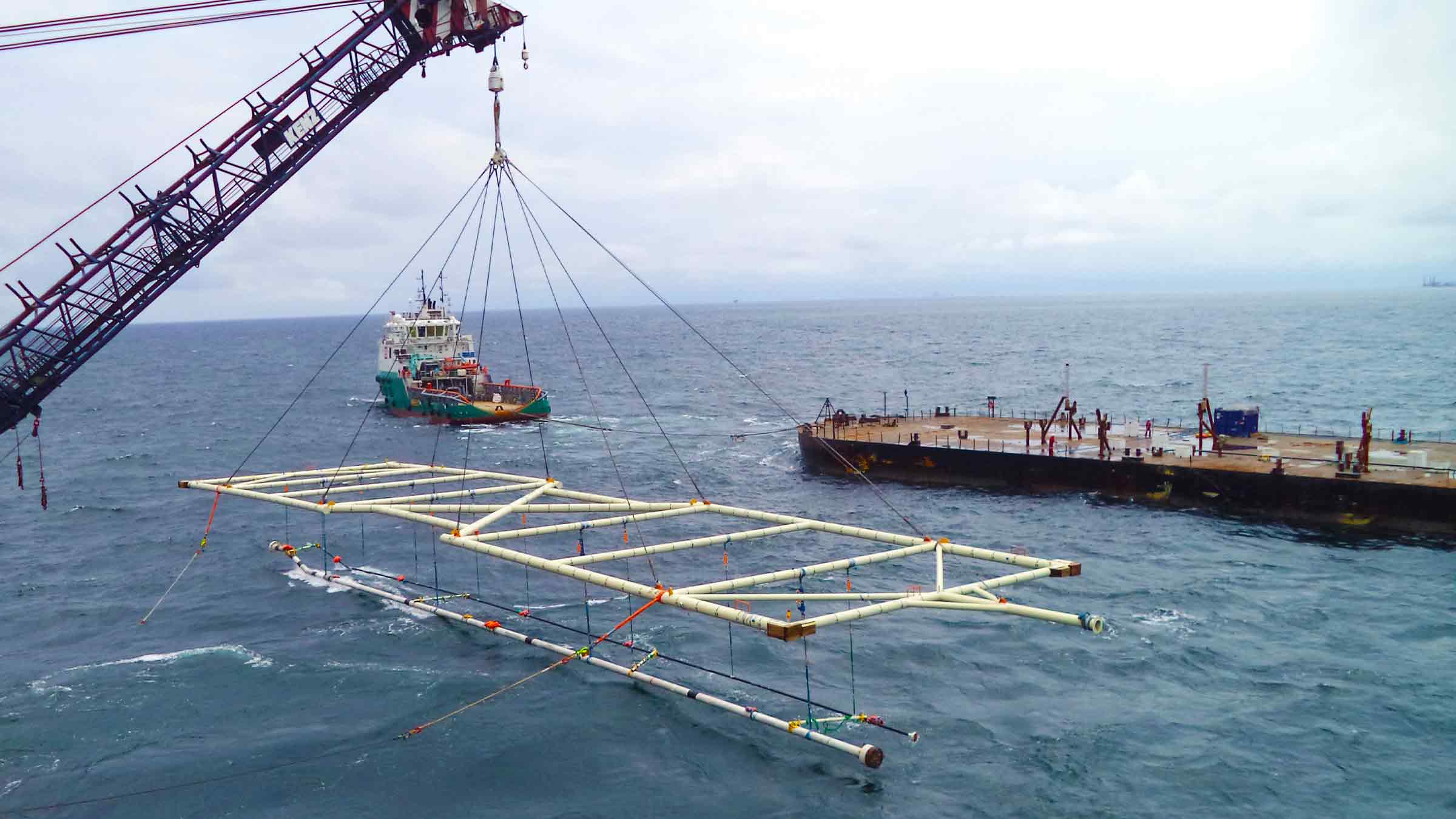
RT 6-6000
Release Transponder 6 (RT 6-6000) is a tough, reliable oceanographic release transponder designed for a deep water applications with energy, defence and science. Suitable for a wide range of sustained observation tasks spanning years of in-situ measurements. Depth rating to 6,000 metres and 1,275 kg WLL. Release with Ranger 2.
Depth rating 3,000/6,000 m
Frequency MF/LMF
Working load limit 1,275 kg
Battery life >32 months
Topside Deck Topside /Ranger 2 USBL
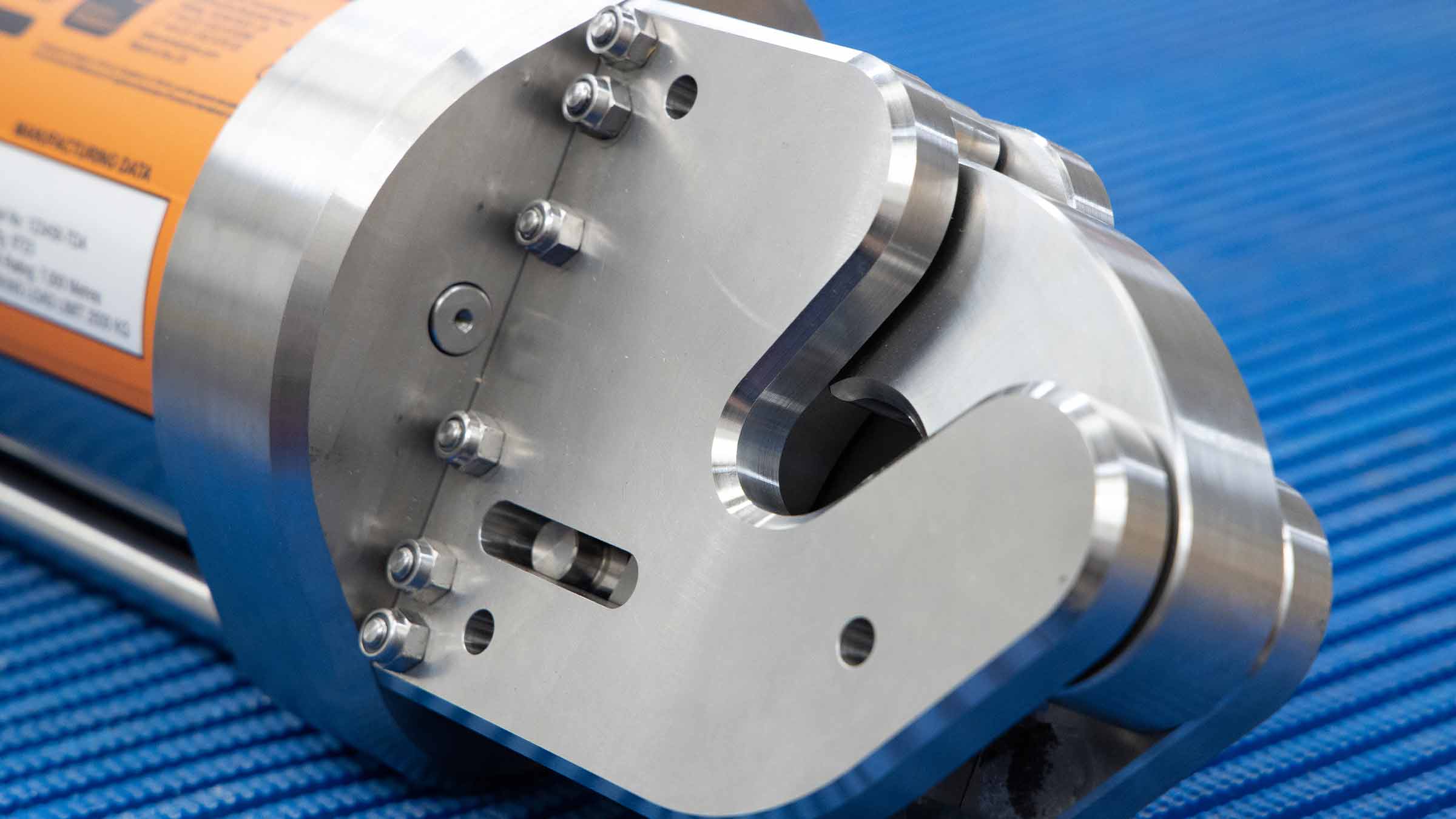
RT 6-HD
Release Transponder 6 Heavy Duty (RT 6-HD) is a tough, reliable, acoustic release transponder engineered with a Working Load Limit of 2,500 kg and fully compatible with LMF Ranger 2 USBL and LMF Deck Topside systems. A deep and heavy load-rated release to support applications from telecomms cable repair to structure installation. Track every moment with your vessel’s Ranger 2.
Depth rating 7,000 m
Frequency LMF
Working load limit 2,500 kg
Battery life >32 months
Topside Dunker kit/Ranger 2 USBL
Frequently asked questions
6G
Our 6th generation (6G) technology provides faster, secure and robust data communications from seabed to surface . This gives you speedier updates on the location of your assets and access to your vital data.
Wideband
Our wideband technology enables digital high-throughput data, range resolution and accuracy with low latency. Teamed with our 6G it gives you fast, reliable, accurate data over greater distances.
Robotics
Uncrewed, autonomous surface and underwater vehicles are increasingly used for coastal, deep sea and over-the-horizon operations, reducing costs, risks and carbon footprint. Thats why we have a dedicated “bolt on” pack for our Ranger 2 to enhance your robotics operations.
Dynamic positioning
We’ve been engineering high integrity position reference systems for dynamically positioned vessels since the early 1990s. Our USBL, LUSBL and SPRINT- INS products provide dynamic positioning solutions for a range of vessels and environments.
Overview
Dynamic Positioning Transponder 6 (DPT 6) supports Wideband 2 acoustic ranging and telemetry providing high accuracy positioning, robust performance in noisy and multi-path conditions and easy set-up and use.
With hundreds of channels, less interference to and from other acoustic systems and multi-user capability, Wideband 2 enables easier SIMOPS vessel capability. These features of the DPT 6 help de-risk subsea operations and save vessel time and cost.
At a glance
- Compatible with HPR systems
- Up to 7,000 m depth rating
- Advanced multi-user/multi-vessel capability
- Robust acoustic performance in noisy conditions
- Real-time diagnostics available on ranges to enable quality control
The DPT 6 is the standard length version and is based on the field proven mechanics of the previous version but with improvements to the end cap closure mechanisms. The design offers the perfect balance between size, acoustic output and battery life. Several depth ratings are available (3,000 m, 5,000 m and 7,000 m) all hard anodised aluminium alloy with protective polyurethane sleeve. Midi (shorter) and maxi (long endurance) options are also available. The DPT is fitted as standard with a highly reliable release mechanism to enable the unit to be deployed in a flotation collar and recovered to the surface without ROV intervention.
The DPT 6 is a midi-sized unit for deep water towfish tracking. Depth rated to 7,000 m, the unit is fitted with a high power super directional transducer. The DPTi 6 is fitted with internal inclinometers to accurately monitor riser angles (see separate datasheet). The unit can also be used with an external inclinometer unit to monitor BOP and flex joint angles.
Specifications table
| Feature | Type 8301-3111 | Type 8301-3113 | Type 8301-5213 | Type 8301-7213 | |
|---|---|---|---|---|---|
| Depth Rating | 3,000 m | 3,000 m | 5,000 m | 7,000 m | |
| Operating Frequency | MF (20–34 kHz) | MF (20–34 kHz) | MF (20–34 kHz) | MF (20–34 kHz) | |
| Transducer Beam Shape | Omni-directional | Directional | Directional | Directional | |
| Transmit Source Level (dB re 1 µPa @ 1 m) | 187–196 dB (4 levels) |
190–202 dB (4 levels) |
190–202 dB (4 levels) |
190–202 dB (4 levels) |
|
| Tone Equivalent Energy (TEE)1 | 193–202 dB | 196–208 dB | 196–208 dB | 196–208 dB | |
| Receive Sensitivity (dB re 1 µPa) | 90–120 dB (7 levels) |
80–120 dB (7 levels) |
80–120 dB (7 levels) |
80–120 dB (7 levels) |
|
| Ranging Precision | Better than 15 mm | Better than 15 mm | Better than 15 mm | Better than 15 mm | |
| Number of Unique Addresses Wideband 1 & 2 | >500 | >500 | >500 | >500 | |
| Battery Life (Listening) | Alkaline | 833 days | 833 days | 833 days | 833 days |
| Lithium | 1,390 days | 1,390 days | 1,390 days | 1,390 days | |
| Safe Working Load (4:1) (Release Mechanism) | 250 kg | 250 kg | 250 kg | 250 kg | |
| Dimensions (Maximum) (Length x Diameter) |
With Sensor Guard | 1,034 x 200 mm | 1,034 x 200 mm | 1,034 x 200 mm | 1,034 x 200 mm |
| Without Sensor Guard | 1,034 x 178 mm | n/a | n/a | n/a | |
| Weight in Air/Water2 | 23.8/11.8 kg | 27.0/14.0 kg | 29.0/15.0 kg | 33.3/18.8 kg | |
| Endcap Sensors and Options | |||||
| Temperature (±0.1°C) | Standard | Standard | Standard | Standard | |
| Tilt Switch (±30–45°) | Standard | Standard | Standard | Standard | |
| Strain Gauge Pressure Sensor (±0.1%) | Standard | Standard | Standard | Standard | |
| High Precision Strain Gauge (±0.01%) Presens or Keller |
Optional | Optional | Optional | Optional | |
| Paroscientific DigiQuartz Pressure Sensor 1,350 m, 2,000 m, 4,130 m, 6800 m (±0.01%) |
Optional | Optional | Optional | Optional | |
| Inclinometer (Tilt Sensor) Range ±90°, Accuracy: ±1° |
Standard | Standard | Standard | Standard | |
| High Accuracy Inclinometer Range: ±90°, Accuracy: ±0.05° over 0 – ±15°; ±0.2° over 0 – ±45° |
Optional | Optional | Optional | Optional | |
| Sound Velocity Sensor ±0.02 m/s Accuracy Under Calibration Conditions |
Optional | Optional | Optional | Optional | |
| Release Mechanism | Standard | Standard | Standard | Standard |
Frequently asked questions
Software and firmware
Software and control hardware
Technical bulletin
Overview
With a high manufacturing tolerance combined with a pop-up ‘tell-tale’ flag that provides visual confirmation the transponder is precisely docked, our stab and receptacle saves times and improves the accuracy of subsea construction.
Using our stab and receptacle, the traditional method of rotating of a stab in a hub during metrology operations to determine stab-to-receptacle slop, can be eliminated. With this time consuming task removed, acoustic metrologies have the potential to be completed in less than six hours.
The tolerance of the design allows for 0.1° for heading and 0.01° for pitch/roll which is the same quoted error of a calibrated Gyro Compatt 6. This improves the results of the metrology or other positioning tasks and reduces the need for error determination of the stab/receptacle.
At a glance
- Allows you to accurately align transponders on structures
- Perfect for installation during metrology campaigns
- Allows transponders to be quickly removed and re-installed using ROV
- Two stab variants available to bolt onto either Inclinometer Compatts or Gyro Compatts
- Can be fitted on the back deck using existing hole patterns
- Tell-tale indicator confirms the stab is fully docked into the receptacle
The receptacle is designed to bolt into the eight bolt hole pattern of the industry standard 8” AWWA Class D flange. This allows the user to either bolt this flange onto the structure or to provide bolt holes in the structure itself. After dimensional control techniques to determine the relationship of the bolt holes in relation to the structure points of interest (jumper hubs, CRP, spool flanges, etc), the receptacle can be bolted in with known offsets to these points. This allows fast and precise inferred metrology to one or multiple hubs or flanges from a single receptacle.
The receptacle features a 45° cone in which the stab sits. This reduces the possibility of debris building up on the interface between the two and allows for a more precise connection due to the point of contact being exactly circular regardless of any small expansion/contraction effects.
The stab also features an alignment bar rather than alignment pins to aid docking and provide superior heading alignment. An O-ring on the stab shaft assists in ensuring the two are precisely mated.
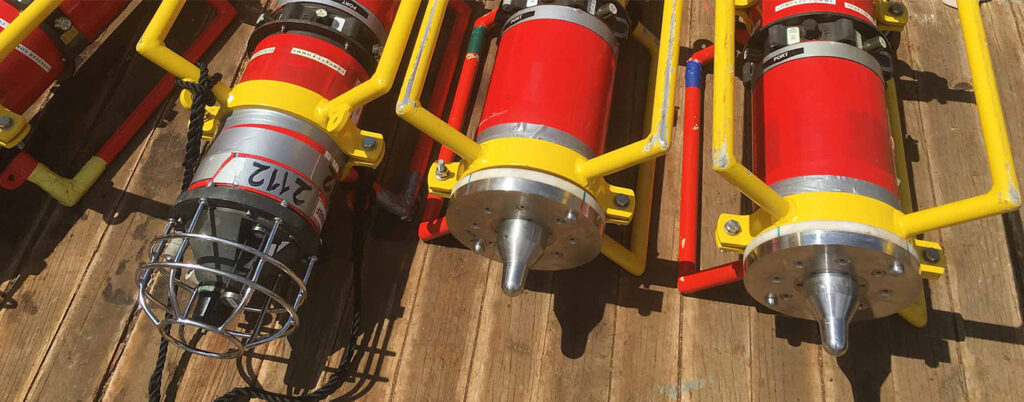
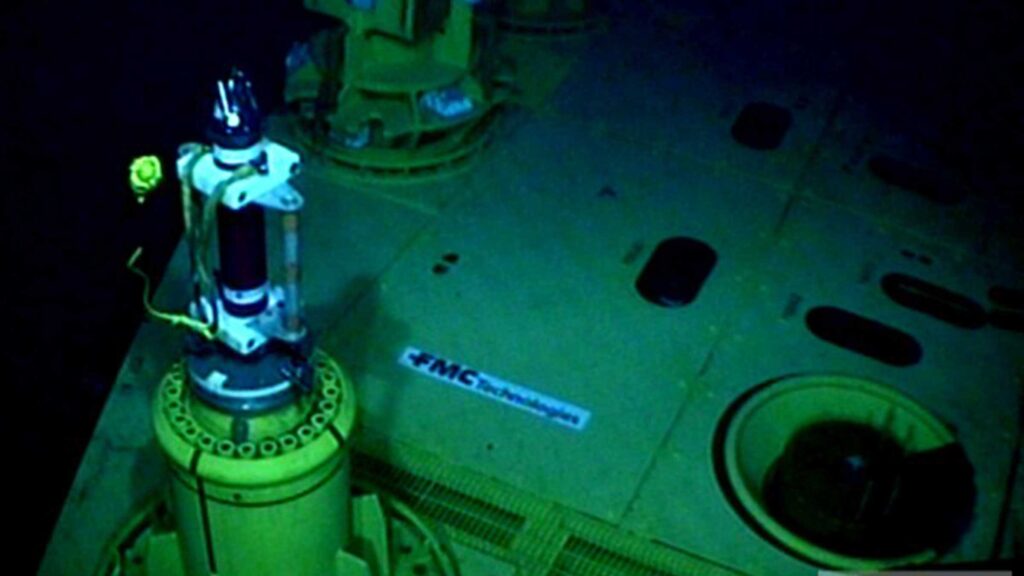
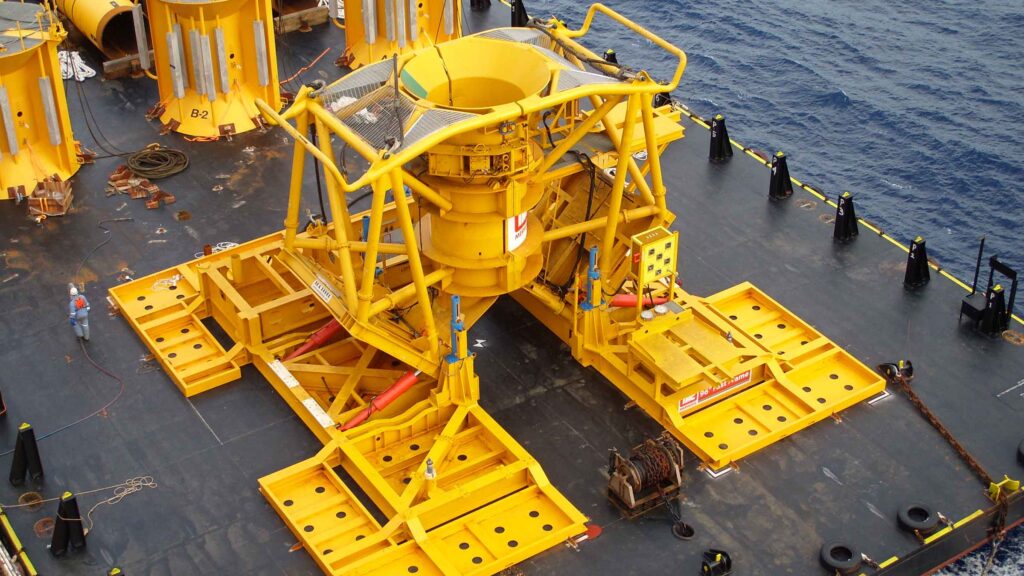
Specifications table
| Feature | Receptacle Type 8300-250 | Stab Type 8300-240 | Stab Type 8144-150 |
|---|---|---|---|
| Compatible Products | Stab 8300-240 & 8144-150 | Inclinometer Compatt 5 & 6 | Gyro Compatt 6 |
| Outside Diameter | 343 mm | 185 mm | 185 mm |
| Maximum Height | 100 mm | 164 mm | 164 mm |
| Stab face to Flange Face | 76 mm | 76 mm | 76 mm |
| Mechanical Construction | Acetal (Delrin) | Super duplex stainless steel | Super duplex stainless steel |
| Bolt Hole PCD | Removable | n/a | n/a |
| Tell-tale | Removable | n/a | n/a |
| Attitude Tolerance | Heading 0.1°, Pitch / Roll 0.01° | Heading 0.1°, Pitch / Roll 0.01° | Heading 0.1°, Pitch / Roll 0.01° |
| Alignment Quadrants | Four (0°, 90°, 180°, 270°) | Four (0°, 90°, 180°, 270°) | Four (0°, 90°, 180°, 270°) |
Datasheets
Did you know?
There are two stab variants available to be used with either Compatts or Gyro Compatts
Overview
Acoustic release transponders are a vital piece of ocean equipment – relied upon by energy, defence and science users to moor valuable equipment strings for years at a time, and when commanded to do so, reliably return equipment and logged data to the surface.
Transponders need to be tough, reliable and easy to work with. RT 6-6000 meets these requirements.
Part of our new range of acoustic releases, RT 6-6000 combines the extensive mechanical design track record of our renowned ORTs and DORTs with the flexibility of our 6G platform, resulting in enhanced battery life and perhaps most significantly, compatibility with our Ranger 2 USBL family
With RT 6-6000, you can use your vessel’s Ranger 2 USBL to deploy, track, locate and command the instrument – removing the need for a separate topside unit. If you don’t have access to a Ranger 2 USBL, our rugged and lightweight Deck Topside with an over-the-side dunker is all you need to both configure and command RT 6-6000s.
At a glance
- Tested, loaded, deployed and released using Deck Topside
- Also works with Sonardyne Ranger 2 USBL to deploy, track and command in very deep water
- Highly reliable release mechanism design and thousands are in service globally
- Working Load Limit 1,275 kg (4:1)
- Depth rated to 6,000 m
- External battery disconnect to maximise battery life with no need to open unit
- Compact and rugged design
RT 6-6000s are most commonly used to anchor oceanographic moorings to the seabed. However, their compact size and compatibility with Ranger 2 makes them ideal for incorporation into instrument frames or lowered platforms to enable deployment of sub-system packages.
Standard features include a Working Load Limit of 1,275 kg (at 4:1) and a spring-assisted release mechanism. RT 6-6000 is compatible with our standard tandem and high-load release frames for scenarios requiring a higher WLL. Speak to us about your requirements as custom frames are also an option.
A battery disconnect fob is located on the transducer and uses an internal magnetic switch to electronically disconnect the battery when not in use. This means you do not have to open the unit to manually disconnect the battery, saving time and reducing the risk of incorrect re-assembly.
RT 6-6000s use the same trusted spring-assisted release mechanism that has been in service for many years and used on thousands of Sonardyne transponders globally.
Choice of topsides
You can use our rugged Deck Topside, or if you’ve got access to a Ranger 2 USBL system on your survey or research vessel, then you have everything you need to control your RT 6-6000.
Versatile
RT 6-6000 is more than just an acoustic release. It can be tracked with our Ranger 2 USBL making relocating and recovering it fast and simple.
High WLL
Use it with our Heavy-Duty Release Frames and significantly increase your Working Load Limit when deploying seabed structures.
Support
You can find a wide range of support articles for our family of acoustic release transponders on our knowledge base.
Specifications table
| Feature | Type 8321-6250 |
|---|---|
| Depth Rating | 6,000 m |
| Operating Frequency | LMF (14–19 kHz) |
| Transducer Beam Shape | Hemispherical |
| Transmit Source Level (dB re 1 µPa @ 1 m) | 188 dB |
| Tone Equivalent Energy (TEE) | 192 dB |
| Receive Threshold (dB re 1 µPa) | <90 dB |
| Working Load Limit (4:1) | 1,275 kg |
| Proof Load | 2,550 kg |
| Breaking Load | 5,100 kg |
| Maximum Safe Release Load | 1,700 kg |
| Battery Life (Alkaline) | >32 months active |
| Inclinometer Accuracy | ±5° |
| Surface Unit | Deck Topside, Ranger 2 USBL |
| Mechanical Construction | Aluminium bronze and duplex stainless steel |
| Operating Temperature | -5 to 40°C |
| Storage Temperature | -20 to 55°C |
| Dimensions (Length x Diameter | 700 x 142 mm (27.5 x 5.6”) |
| Weight in Air/Water | 20/15 kg |
| Standards | CE Marked to EN-60945, EN-61010 |
| Options | Deep Water Deck Kit (Deck Topside) – 602-0180 |
| Heavy Duty Release Frames (7.5 T, 15 T and 25 T) |
Frequently asked questions
What is an Acoustic Release and how does it work?
Why isn’t serial communication available using the iWand in RT 6 Dunker Mode?
6G Terminal Lite Range Test
What is the safe working load for different RT 6 products?
What should I use instead of an ORT and DORT?
How to correctly set an RT 6-6000 release mechanism
How to change the battery on an RT 6-3000 or RT 6000
How to load the release on an RT 6-3000 and RT 6-6000
Which RT 6 is correct for my operations?
How to release an RT 6 acoustic release transponder using Ranger 2
How long can an RT 6-3000 and RT-6 6000 be deployed for?
Deployment
STP files
Software and control hardware
Manuals and quick start guides
Did you know?
RT 6-6000 can be used with our Ranger 2 USBL family or Deck Topside
Overview
ROVNav 6+ uses our new Wideband 3 signal technology, which is key to unlocking the benefits of your Fusion 2 LBL system.
It allows, for the first time, sensor telemetry data (e.g. pressure, depth or temperature) from a seabed or structure deployed Compatt 6+ to be embedded within navigation (ranging) data. This change has a big impact on operations such as structure installation, as breaks in tracking to get sensor reading updates at vital moments are now a thing of the past.
Its compatibility with Wideband 3 and Wideband 2 telemetry commands, and support of high power Wideband 2 ranging protocols, proven for their accuracy and robustness, means the ROVNav 6+ offers improved range and acoustic performance in challenging conditions such as on noisy vehicles or in multipath environments.
At a glance
- High power, long range LBL transceiver for ROVs
- Wideband 3-enabled supporting embedded sensor data with ranging data
- Optimised for Fusion 2 and compatible with Fusion 1
- 3,000, 5,000 or 7,000 m depth rated options
- USBL mode for emergency ROV relocation
- Modem mode for harvesting data from Sonardyne logging sensors; Fetch, AMT…
ROVNav 6+ is also a fully functional USBL responder or transponder, compatible with Wideband 2 USBL systems and HPR400. The internal li-ion rechargeable battery pack also enables emergency transponder mode, so if the umbilical and therefore power is cut to the ROV it can still be located by USBL.
The omni-directional remote MF transducer makes installation on an ROV easy. ROVNav 6+ is designed to be rugged and relatively lightweight and utilises robust underwater connectors. ROVNav 6+ supports a range of internal sensors including: strain gauge pressure, PRT temperature and MEMS based inclinometer.
ROVNav 6+ is also fully compatible with our modem and logging equipment such as AMT and Fetch products, allowing it to be used to retrieve data or configure logging regimes. It supports all of our Wideband 2 and Wideband 3 spread spectrum acoustic communication; 100 to 9,000 bps data rates can be selected depending on the environment.
Sensor options include a Digiquartz pressure sensor, precision inclinometer and altimeter interface. This provides a fully featured ROV manipulator deployable tool/sensor pack for a range of different applications including metrology, bathy survey and structure deployment operations, without the requirement for any additional interfacing on the ROV.
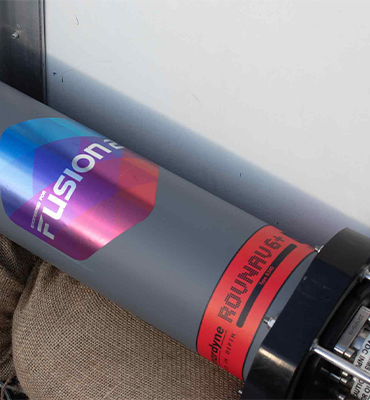
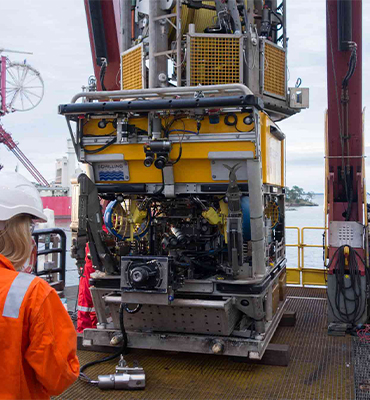
Specifications table
| Feature | 8340-3161 | 8340-5261 | 8340-7261 |
|---|---|---|---|
| Depth Rating | 3,000 m | 5,000 m | 7,000 m |
| Operating Frequency | MF (20–34 kHz) | MF (20–34 kHz) | MF (20–34 kHz) |
| Beam Shape | Omni-directional | Omni-directional | Omni-directional |
| Transmit Source Level (dB re 1 µPa @ 1 m) | 187–196 dB (4 levels) | 187–196 dB (4 levels) | 187–196 dB (4 levels) |
| Range Precision | Better than 15 mm | Better than 15 mm | Better than 15 mm |
| Serial Communications | RS232 or RS485 (half-duplex) | RS232 or RS485 (half-duplex) | RS232 or RS485 (half-duplex) |
| Battery Life Li-ion (Listening) | 3 days | 3 days | 3 days |
| Operating Voltage | 24 or 48 V dc (±10%) | 24 or 48 V dc (±10%) | 24 or 48 V dc (±10%) |
| Serial Communications Connector | Subconn (8-way female) | Subconn (8-way female) | Subconn (8-way female) |
| Remote Transducer Connector | Burton (3-way male) | Burton (3-way male) | Burton (3-way male) |
| Housing Mechanical Construction | Hard anodised aluminium 6082 | Hard anodised aluminium 6082 | Hard anodised aluminium 6082 |
| Remote Transducer Mechanical Construction | Stainless steel 316 | Stainless steel 316 | Stainless steel 316 |
| Dimensions (Maximum) (Length x Diameter) | 768 x 200 mm | 768 x 200 mm | 768 x 200 mm |
| Weight in Air/Water | 14.3/5.3 kg | 14.7/5.7 kg | 15.5/6.0 kg |
Frequently asked questions
If I’m using Fusion 2, can I choose to use Wideband 2 or Wideband 3 telemetry?
Can ROVNav 6+ be used with standard Compatt 6s?
Will my ROVNav 6 work with Fusion 2?
Do I need to upgrade to Compatt 6+ and ROVNav 6+?
Where should I install my ROVNav 6+ transducer?
What are the differences between a ROVNav 6+ and Mini ROVNav 6+ ?
How to QC a Sound Velocity (SV) in Fusion 2
How far can my Compatt 6+ be above the seabed?
How do I perform an LBL calibration in Fusion 2?
STP files
Software and firmware
Transponders
Datasheets
Manuals and quick start guides
Technical bulletin
Did you know?
ROVNav 6+ is compatible with Fusion 1 and can be depth rated up to 7,000 m
Overview
Acoustic release transponders are a vital pieces of ocean equipment – relied upon by energy, defence and science users to moor valuable equipment strings for years at a time, and when commanded to do so, reliably return equipment and logged data to the surface.
Transponders need to be tough, reliable and easy to work with. The RT 6-HD meets these requirements.
Part of our new range of acoustic releases, RT 6-HD combines the extensive mechanical design track record with the flexibility of our 6G platform, resulting in enhanced battery life and perhaps most significantly, compatibility with our Ranger 2 USBL system.
At a glance
- Tested, loaded, deployed and released with Deck Topside
- Also works with Ranger 2 USBL to lift, lower and track heavy subsea structures in deep water
- Working Load Limit 2,500 kg (4:1)
- Depth rated to 7,000 m
- Highly reliable release mechanism
- Compact and rugged design
With RT 6-HD, you use your vessel’s Ranger 2 USBL to deploy, track, locate and command the instrument – removing the need for a separate topside unit. If you don’t have access to a Ranger 2 USBL, our rugged and lightweight Deck Topside with an over-the-side dunker is all you need to both configure and command RT 6-3000s.
With a WLL of 2,500 kg (at 4:1), twice that of our RT 6-3000 and RT 6-6000, RT-HD is designed for specialist heavy lift application scenarios such as deep water construction and salvage.
RT 6-HD is also our deepest rated acoustic release transponder at 7,000 m. Excellent corrosion resistance is achieved by using super duplex stainless steel for the housing materials.
RT 6-HD is configured with our iWand hand-held acoustic transponder test and configuration device.
High WLL
The highest standard WLL of 2,500 kg of any of our transponders without any additional load amplification frames.
Choice of topsides
You can use our rugged Deck Topside or, if you’ve got access to a Ranger 2 USBL system on your survey or research vessel, then you have everything you need to control your RT 6-HD.
Versatile
RT 6-HD is more than just an acoustic release. It can be tracked with our Ranger 2 USBL making relocating and recovering it fast and simple.
Specifications table
| Feature | Type 8322 |
|---|---|
| Depth Rating | 7,000 m |
| Operating Frequency | LMF (14–19 kHz) |
| Transducer Beam Shape | Hemispherical |
| Transmit Source Level (dB re 1 µPa @ 1 m) | 188 dB |
| Tone Equivalent Energy (TEE) | 192 dB |
| Receive Threshold (dB re 1 µPa) | <90 dB |
| Working Load Limit (4:1) | 2,500 kg |
| Proof Load | 5,000 kg |
| Breaking Load | 10,000 kg |
| Battery Life (Alkaline) | >36 months active |
| Inclinometer Accuracy | ±5° |
| Surface Unit | Deck Topside, Ranger 2 USBL |
| Mechanical Construction | Super duplex stainless steel |
| Operating Temperature | -5 to 40°C |
| Storage Temperature | -20 to 55°C |
| Dimensions (Maximum) (Length x Diameter) | 691 x 164 mm |
| Weight in Air/Water | 24.5/20 kg |
| Options | Deep Water Deck Kit (Deck Topside) – 602-0180 |
Frequently asked questions
Software and control hardware
Manuals and quick start guides
Did you know?
RT 6-HD can be deployed using Deck Topside
Overview
Compatt 6+ is used for high precision survey and construction operations in all water depths, including: spool piece metrology, pipeline touchdown monitoring, structure installation and dynamic positioning reference.
Compatt 6+ offers significant time saving with fast update rates (up to 1 Hz LBL tracking), all made possible using the Wideband 3 acoustic telemetry protocols. Support of Wideband 2 ranges maintains backwards compatibility. This makes any system operating with Compatt 6+ significantly easier to operate therefore de-risking operations, reducing vessel time and reducing training requirements for offshore personnel.
At a glance
- Compatible with all 6G LBL, INS and USBL systems
- Wideband 3 enabled
- Versatile, flexible and cost-effective
- Over 3,600 different configurations available
- Choice of depth ratings to 7,000 m
Our Wideband advanced signal processing offers improved acoustic performance in challenging conditions, longer ranges, improved multipath rejection around structures and real-time range diagnostics for quality control. Wideband also reduces the interference to and from adjacent Sonardyne and other acoustic positioning systems.
The integrated communications and navigation technology allows the transponder to be used as a multi-purpose modem, autonomous data logger and navigation reference transponder.
Wideband 3
For the first time, sensor telemetry data (e.g. pressure, depth or temperature) is embedded within ranging data so no more waiting for sensor readings at vital moments.
Compatible
Compatt 6+ transponders are backwards compatible with your existing Compatt 6 inventories so you can mix and match in the field.
Upgradable
We can upgrade your existing Compatt 6 into plus units quickly and cost effectively meaning you can go on to realise the full benefits of Fusion 2.
Overview
Compatt 6+ is used for high precision survey and construction operations in all water depths, including: spool piece metrology, pipeline touchdown monitoring, structure installation and dynamic positioning reference.
Specifications table
| Feature | Type 8300-3111 | Type 8300-3113 | Type 8300-5213 | |
|---|---|---|---|---|
| Depth Rating | 3,000 m | 3,000 m | 5,000 m | |
| Operating Frequency | MF (20–34 kHz) | MF (20–34 kHz) | MF (19–34 kHz) | |
| Transducer Beam Shape | Omni-directional | Directional | Directional | |
| Transmit Source Level (dB re 1 µPa @ 1 m) | 187–196 dB (4 levels) | 190–202 dB (4 levels) | 190–202 dB (4 levels) | |
| Tone Equivalent Energy (TEE) | 193–202 dB | 196–208 dB | 196–208 dB | |
| Receive Sensitivity (dB re 1 µPa) | 90–120 dB (7 levels) | 80–120 dB (7 levels) | 80–120 dB (7 levels) | |
| Ranging Precision | Better than 15 mm | Better than 15 mm | Better than 15 mm | |
| Number of Unique Wideband 2 Addresses | >300 | >300 | >300 | |
| Battery Life (Listening) | Alkaline | 833 days | 833 days | 833 days |
| Lithium | 1,390 days | 1,390 days | 1,390 days | |
| External Power Supply | 24 V | 24 V | 24 V | |
| Safe Working Load (4:1) | 250 kg | 250 kg | 250 kg | |
| Operating Temperature | -5 to 40°C | -5 to 40°C | -5 to 40°C | |
| Storage Temperature | -20 to 55°C | -20 to 55°C | -20 to 55°C | |
| Dimensions (Maximum) (Length x Diameter) |
With Sensor Guard | 1,034 x 200 mm | 1,018 x 200 mm | 1,018 x 200 mm |
| Without Sensor Guard | 1,034 x 178 mm | n/a | n/a | |
| Weight in Air/Water | 23.8/11.8 kg | 27.0/14.0 kg | 29.0/15.0 kg | |
| Endcap Sensors and Options | ||||
| Temperature (±0.1°C) | Standard | Standard | Standard | |
| Tilt Switch (±30–45°) | Standard | Standard | Standard | |
| Strain Gauge Pressure Sensor (±0.1%) | Standard | Standard | Standard | |
| High Precision Strain Gauge (±0.01%) Presens or Keller |
Optional | Optional | Optional | |
| Feature | ||||
| Paroscientific DigiQuartz Pressure Sensor 1,350 m, 2,000 m, 4,130 m, 6,800 m (±0.01%) |
Optional | Optional | Optional | |
| Inclinometer (Tilt Sensor) Range ±90°, Accuracy: ±1° |
Standard | Standard | Standard | |
| High Accuracy Inclinometer
Range: ±90°, Accuracy: ±0.05° over 0 – ±15°; ±0.2° over 0 – ±45° |
Optional | Optional | Optional | |
| Sound Velocity Sensor ±0.02 m/s Accuracy Under Calibration Conditions | Optional | Optional | Optional | |
| Release Mechanism | Standard | Standard | Standard | |
| Power for External Sensors | Standard | Standard | Standard | |
| Gyro Input | Standard | Standard | Standard |
Frequently asked questions
Compatt 6 and 6+ Deployment Tests
Frequency management is obsolete. Here’s why.
6G Terminal Lite Range Test
When to use a float, when to use a stand?
How can I get the best performance from my long layback tracking operations?
How can I deploy my Compatt 6+ using iWand?
How to correctly set a Compatt 6+ release mechanism
Does Compatt 6+ have modem capabilities?
How often do endcap sensors need calibrating to keep them in spec?
Is it possible to position Compatt 6+s independently within the same array and send each positioning out of Fusion to our navigation software?
Will Compatt 6+ work with Ranger 2 and Marksman?
I want to buy standard red Compatt 6, are they still available for sale?
Can Compatt 6+ be used in the same LBL array as standard Compatt 6?
What is the difference between Compatt 6 and Compatt 6+?
If I’m using Fusion 2, can I choose to use Wideband 2 or Wideband 3 telemetry?
Can ROVNav 6+ be used with standard Compatt 6s?
Will my ROVNav 6 work with Compatt 6+?
Do I need to upgrade to Compatt 6+ and ROVNav 6+?
How to QC a Sound Velocity (SV) in Fusion 2
How far can my Compatt 6+ be above the seabed?
How to replace a battery in Compatt 6 and 6+ family of transponders
How to plan my sparse LBL array (guidance note)
How do I calibrate my sparse LBL array?
How do I set up structure deflection monitoring (SDM) in Fusion 2?
Can I use Compatt 6+ Multiuser in Fusion 2?
How do I perform a SLAM calibration in Fusion 2?
How do I set up sound speed collection and pressure to depth conversion in Fusion 2?
Software and firmware
Software and control hardware
Transponders
Datasheets
Manuals and quick start guides
Did you know?
Compatt 6+ uses Wideband 3 technology
